

Mercedes Benz
Table of Contents
What is Suspension Travel?

In this brief article, we will discuss the Suspension Travel and the Suspension travel found in various types of suspension.
Suspension travel is defined as the maximum vertical distance that the wheel can travel from the fully extended ‘Rebound’ condition to the fully compressed ‘Full Bump’ condition.
‘Bump Travel’ is defined as the distance traveled by the wheel center from Normal ride height to Full Bump condition.
‘Rebound Travel’ is defined as the distance traveled by the wheel center from Normal ride height to Rebound condition.
The ‘Bump travel’ is limited by the provision of Bump stop rubber blocks that compress and stop further travel before metal-to-metal contact. In most cars, the ‘rebound travel’ is limited by rebound rubber buffers inside the shock absorbers that stop the wheel hubs from dropping beyond the fully extended length of the shock absorber.
How is Suspension travel calculated?
Suspension travel is mostly dependent on the stiffness of the spring selected for the suspension. While designing a suspension system, ideally, a spring stiffness should be selected:
- ‘Soft’ enough to give not too harsh a ride, but yet is
- ‘Stiff’ enough to absorb the energy of road shocks without hitting the bump stops too often.
Additionally, the springs must also be stiff enough to prevent excessive roll on corners, but this is not always required since roll stiffness can be specifically handled by the use of an anti roll bar and not increasing the spring stiffness.
The normal rule of thumb in design is to allocate:
- ⅔ of the total suspension travel to ‘Normal ride height -to- Full Bump’ and,
- ⅓ of the total suspension travel to ‘Normal ride height-to-Rebound’
How is Bump travel decided?
A rough rule is that the stiffness and bump travel have to be both selected such that the spring stiffness progressively increases and can take a load of ‘2g’ or twice the corner weight before the point of full-bump travel is reached. The intention is that, while driving on normal roads, the car suspension should not be continuously hitting against the bump stops, either due to too much softness in the springs or less bump travel. Bump stop hitting causes a great amount of discomfort to the occupants.
In order to control bump stop hitting is to make the spring slightly stiffer than its normal rate as the wheel gets closer to its upper limit, or bump stop. This is called ‘progressiveness’ of the spring rate. The progressiveness of the suspension rate can be achieved using
- A progressive coil spring
- A rubber bump stop buffer
Why is Rebound travel important?
Ideally, the suspension must allow the wheels to move up and down in such a way that they follow the unevenness of the road while maintaining the body to ride as level as possible.
So the Rebound travel should be such that the suspension is able to maintain tire-to-road contact at all times. The shock absorber rebound stop contact must be avoided, or, the wheels must not hang in air, since this is a source of discomfort to the occupants.
The rebound travel must also take into account vehicle roll during cornering. The inside tire during extreme cornering maneuvers must not lift off the ground. Tire lift off during cornering will drastically reduce lateral grip since grip is proportional to tire contact area and vertical load.
How much Suspension Travel do Cars have?
In most common street applications, the suspension travel ranges in the following manner:
Suspension travel is different for different vehicle applications:
- For Trucks and off-road vehicles, the suspension travel is usually 4” of travel from normal ride height to both bump and 4” inches of travel to rebound.
- For track applications 3” of travel from normal ride height to both bump and 2” inches of travel to rebound.
Is it possible to Increase suspension travel?
Yes, it is possible to achieve more suspension travel. The situation where this would be required is if you intend your vehicle to have Off-roading capability. In Off-Roading, a greater wheel articulation would help you tackle various sorts of uneven terrain.
But compared to Decreasing suspension travel, increasing suspension travel requires comparatively more modifications. What is basically needed is:
- Increased Normal ride height, or, the vehicle must sit higher when unladen
- Increased Rebound travel, or, the wheel must drop further downwards.
In order to achieve the above, you would need to replace your vehicle’s factory suspension with an aftermarket Off-Roading Kit. Depending on the vehicle you own, you would need to look for a supplier that has compatible parts. One important point to note is that your car/truck was designed by the OEM specifically for the current ride height. So changing this setup cannot be done using ready-to-fit parts. You would need to make several chassis/underbody modifications in order to achieve your goal.
Superlift, ReadyLift, Icon Vehicle Dynamics, BDS Suspension and Rough Country are some of the many brands available in the market.
If you are trying to Lift your truck suspension , then some of the changes that would be required to the vehicle would be
- Modified Cross members that lower the support position of the suspension brackets. This may require you to remove the chassis bracket and maybe cut and re-weld the aftermarket parts onto them. Make sure you have a really experienced person to do this as it is a high-precision job.
- Modified front differential mounting brackets (in the case of a 4X4 vehicle)
- Long-travel Shock absorbers to replace the OE parts
- Longer travel coil Springs (if your vehicle has coil springs)
- Modified higher camber and long-travel leaf springs (if your vehicle’s rear suspension has leaf springs)
- Modified anti-roll bar chassis mounts and drop-links. Since the wheels sit lower than the original position, the anti-roll bar’s position will also need to be lowered so that it can function properly at the new height.
- Before starting out on the modifications, you need to decide whether you are going to someday go back to the original OE setup or not.
- If you intend to put back the OE parts, you need to be mindful of the original parts and store them properly as a set. Also, you may not be able to reverse some of the cutting and welding that you may do during lifting. So you would need to replace original OE brackets in those cases.
Is it possible to Decrease Suspension Travel?
Yes, it is possible to Decrease Suspension travel, or in other words, lower the car. The most common reasons for doing this would be
- To make your car look cooler. It is a known fact that lowered cars give the impression of sportiness to anyone looking at it.
- To make the car functionally perform better on the race track.
There are several aftermarket parts suppliers to choose from, when it comes to getting your car lowered . You need to choose a reputed company that has experience in modifying your particular car model, or brand at least. Or the other way would be to source each of the best aftermarket replacement parts from multiple specialist suppliers who are experts in manufacturing a particular part, e.g Shocks might be a specialty of one company, while lowering springs would be a specialty of another manufacturer.
The changes that would be required are:
- Lowering Springs: The aftermarket lowering springs would be of shorter length and be of a higher and more progressive rate in order to make the suspension work within the reduced travel.
- Aftermarket Coilovers or shock absorbers: The new lowered stance would mean a higher spring rate with lesser travel. The original shock absorbers were tuned for comfort and more travel. The new shock absorbers would require a different damping ratio to account for the new springs. With a shorter spring, the suspension arm would be able to travel more into the bump, closer to the bump stop. This would require a shorter ‘shut height’ in the new shock absorber/Strut.
- Modified control arms of higher strength would be required since the bump stops would be hitting more number of times.
- Low Camber leaf spring and axle mounts: In the case of leaf springs, you would probably need a new set of springs and slimmer axle mounts.
- UnderSlung Axle: For a leaf spring suspension , if it was an overslung axle, there might be potential to convert it to an underslung using an aftermarket kit. The axle will sit above the spring, thus bringing the chassis closer to the ground
- Torsion Bar Key : For a Torsion bar suspension, lowering can be easily done without any additional aftermarket parts. The only thing to be done is to readjust the zero rotational position of the torsion bar.
After-effects to expect when Lowering the Suspension
- Poor or harsh ride quality
- Underbody scraping when going over bumps or steeply inclined driveways
In this brief article, we have discussed the Suspension Travel and the Suspension travel found in various types of suspension.
Related Posts
Can a sway bar link make noise, what are the best exhaust brands, is oe tuning worth it.
You are using an outdated browser. Please upgrade your browser to improve your experience.

- Product Lines
- Shoxs Suspension Seats
- Kinetix Impact Monitoring
- Accessories
- Military / Professional
- Recreational
- Seat Selection
- Custom Engineering
- Human Factors
- Performance Testing
- Whole Body Vibration
- About Shoxs
- Impact Science
- United Safety & Survivability Corporation 101 Gordon Drive Exton, PA 19341, United States
- 610-265-3610
- [email protected]
You have no items in your cart, add some on the products page .
- Find a Dealer
- 2024 Catalog
Suspension Travel
Shock size matters, more suspension travel results in a smoother ride.
Imagine a car speeding towards a brick wall. The average force (and acceleration) required to bring a moving body to rest is inversely proportional to the stopping distance. The ability of a shock-mitigating device to lessen an impact and ensure a smooth ride is tied to its stopping distance. It’s the equivalent of gently applying the brakes on the car, allowing it to roll to a halt over some distance.
Acceleration: Defined
We gain further insight by considering the definition of acceleration: the rate of change of velocity with respect to time. When a boat collides with a wave it undergoes a velocity change due to its motion relative to the water’s surface, and so the acceleration will depend on the size of that change and inversely depend on the time over which it occurs. This suggests the two main approaches to lowering impact severity: reduce the impact velocity or increase the time duration of the event.
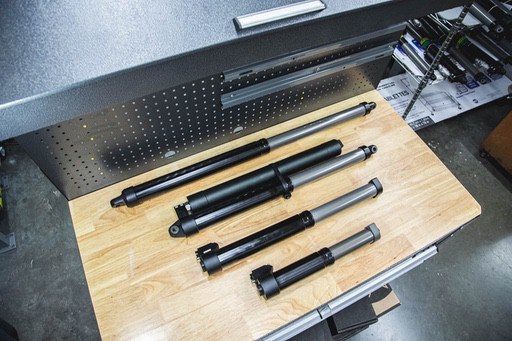
Impact Factors on the Water
On the water, a boat’s hull design, speed, and the sea-state are the dominant factors that dictate the velocity change during a wave slam. This change is thus reduced by improved hull design, slowing down, and avoiding poor conditions. These preventative measures lie at the heart of any shock-reduction strategy, but impacts cannot be eliminated entirely. In certain cases, speed cannot be reduced, waves cannot be avoided, and even the most experienced operator can be caught off-guard.
Milder Rides
Shock mitigating equipment is designed to increase the time duration of each impact. The longer it takes to undergo the impact velocity change, the smoother the ride will be, and adding suspension travel to a shock-mitigating device is a sensible way to achieve this. It’s akin to giving the imaginary car more braking distance before the wall.
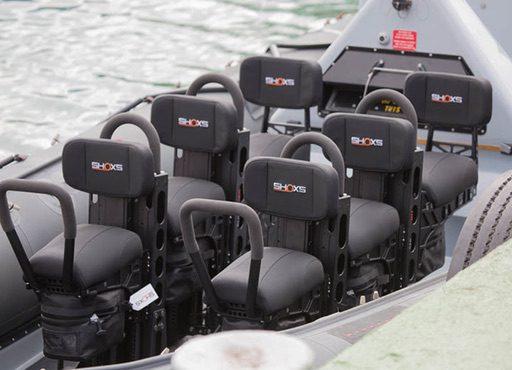
Comparing Suspension Travel Lengths
A longer deceleration leads to lower average forces. This explains why a 1” platform of vibration-mitigating foam is inferior to a 4” travel suspension system when it comes to mitigating shocks. Likewise, a 4” travel suspension will be outperformed by its 10” counterpart. The principle applies to impacts in any direction, including lateral. If only a short suspension travel distance is provided, a proportionate level of shock-mitigation can be expected.
Other Considerations
Of course, there are space and weight limitations on any boat, and ergonomics must be a top priority. Operators must interact with controls, maintain a low profile, and avoid sacrificing their sightlines. But when it comes to shock-mitigation, bigger really is better, and long-travel suspensions will yield the best results.

CarParts.com will be back soon!
We apologize for the inconvenience. The CP Team is working on some upgrades to improve our service. Thank you for using CarParts.com!
You can call us at
1-866-529-0412
Reference ID: 18.7fc733e.1711887560.54a089e2
INTRODUCTION TO SUSPENSION
Why do cars have suspension?
The object of a suspension system is to isolate the body and its occupants from the irregularities of the road surface. Ideally the body should ride level and without vertical motion’ however bumpy the road surface. Another important feature of suspension is that it should keep the tires on the ground all the time. If there were no suspension the tires would tend to lift off the ground every time they passed over a bump at the same time, the shock as the wheels left the ground’ and then came down again, would be transmitted directly to the passengers.
What does a suspension?
Ideally the suspension should allow the wheels to move up and down so that they follow the undulations in the road’ while the body rides level. The first requirement therefore is that the wheels should be able to move vertically relative to the body. Every suspension has this wheel travel, which must be accommodated by some means.
How is the wheel movement accommodated?
Springs are normally used (Figure 1.1). As the tire strikes a bump in the road, so a vertical force is applied to the spring’ which is compressed or deflected. Therefore the wheel moves vertically relative to the body, and the tire maintains contact with the road surface. However, some of this force is transmitted through the spring to the body, which also tends to rise. If the springs are very ‘soft’ (i.e. have relatively low spring rates) the body rises little, but if the springs are very stiff the body rises quite a bit, depending on the severity of the bump. For a good ride, therefore, the springs should be soft.
Do soft springs have any disadvantages?
Although soft springs give a good ride in most circumstances, they allow the body to roll a lot during cornering. In practice, spring rates are a compromise between the requirements of ride and handling.
Why does a car roll?
When a car turns a corner, centrifugal force acts on the body and tends to push it outwards. However, this force is resisted by the tires, which grip the road; as a result, the body rolls about its suspension (Figure 1.2).
What is the disadvantage of roll?
When the car rolls excessively it is more difficult for the driver to control its direction. Also, when the car emerges from the corner and the body rolls back to the upright position, it will roll past the upright position if roll is excessive, and will take some time to right itself. Excessive roll can also make the wheels adopt unfavorable angles, depending on the type of suspension fitted.
Are any other components needed?
In its simplest form the suspension consists purely of the springs and their anchorages. However, when a spring is deflected it attempts to return to its normal position immediately, and if left to itself it goes past the normal position and then back again. It would take a number of these oscillations absorb the stored energy, and only then would the spring return to the normal position.
How is spring oscillation controlled?
Dampers are used to cut down these oscillations so that, after going past the normal position once, the spring soon returns to normal.
SPRINGING REQUIREMENTS
What are the basic requirements of a spring?
Ideally a spring should be arranged so that it is ‘soft’ enough to give a good ride; yet it should be able to absorb all the energy resulting from road shocks without using up all the wheel travel, and it should be stiff enough to prevent excessive roll on corners.
Are all these possible?
Suspension is a compromise between conflicting requirements, but it is possible to gain a good level of performance in all respects, although this can be expensive. First, however, it is necessary to appreciate how these parameters are measured, and how the important figures are calculated.
How is the ‘softness’ of a spring measured?
Every spring has a rate, which is an indication of how much the spring is deflected by load. This is normally indicated as load per unit deflection, given in Newton ’s per millimeter (or pounds-force per inch). However, when it comes to ride, the weight being carried has to be taken into account as well as the spring rate. For example, if a small mass is applied to a spring there is hardly any deflection, whereas a big mass applied to the same spring will give a big deflection, lithe mass is then bounced on the spring, the small mass moves very little, very quickly, whereas the big mass moves up and down quite a long way, but slowly. The amount the mass deflects the spring is called the static deflection, and the rate at which the mass bounces up and down is the natural frequency or periodicity of the spring-mass system.
How is the static deflection found?
The static deflection, D mm, is simply the mass carried divided by the spring rate, i.e. D = mass/spring rate.
How is the natural frequency found?
This is a bit more involved, in that the natural frequency = 30/ cycles/mm, where D is the static deflection, in meters.
What are typical values?
Values vary according to the type of car. For a small saloon the static deflection is often 110-140 mm, and the equivalent natural frequency between 90 and 80 cycles/mm. For a medium-size saloon, the figures might be 130-180 mm, between 85 and 70 cycles/mm; for a large saloon, 180-280 mm, between 70 and 55 cycles/mm. With some very advanced suspensions, figures of over 280 mm or under 55 cycles/mm are obtained.
Do these figures vary with load?
The actual figures for a car vary according to the load carried. When the car is in the kerb condition the frequencies will normally be higher than when it is fully laden, with four people and their luggage in the car. Also, there is normally little difference in the amount of weight carried by the front springs, laden or unladen, but a big difference at the back.
Typical figures for a medium-size saloon are
At the front the difference is small enough to be ignored, but at the rear it makes the ride firmer unladen than when fully laden. Ideally the frequency should remain constant, irrespective of loading, and at a satisfactorily low level.
Can a constant frequency be obtained?
A constant frequency can be obtained only if the spring rate increases in proportion as the load it carries increases. Of course the balance can also be improved by arranging for the increase in weight to be applied equally to the front and rear springs. In practice this is very difficult to arrange.
How is the stiffness of the spring measured in roll?
Basically, the stiffer the spring, the less the car will roll, although the spacing of the springs and the roll-centre height also affect the amount the car rolls. The roll stifThess, which is the measure of the way in which the springs resist roll, is given by:
Roll stiffness = C w x t x 0.08729 N m/deg
for independent suspensions, where C w is the spring rate at the wheel, known as the wheel rate, and t is the track of the car. For beam-axle suspensions:
Roll stiffness = Cs x s 2 x 0.08729 N m/deg
where C s is the spring rate, and s is the spring base, i.e. distance between the effective positions of the left- and right-hand springs.
In simple terms, this means that an increase in either the spring rate or the spring base (or track) will increase resistance to roll, and that more can be gained by increasing the spring base (or track) than by increasing the spring rate.
How can the spring base be increased?
With a beam axle, the spring base is the distance between the springs (Figure 3.1), and the practical width is determined by the necessity of giving clearance around the wheels and brakes.
In practice, this means that the spring base is about 70-80 percent of the track, and that the wheel rate in roll is only about 50-70 per cent of the wheel rate in bump. There is little that can be done to increase the spring base with beam axles.
Is independent suspension better, then?
A better balance between ride and roll stiffness can be obtained with independent suspension, because the wheel rate in bump is the same as it is in roll. So, assuming that the linkages are equally good and that the roll centre of the independent suspension is not very low (see later), independent suspension has this one definite advantage.
Can roll stiffness be increased in any other way?
The addition of an anti-roll bar increases roll stiffness and reduces roll. An anti-roll bar is a horizontal, transverse torsion bar, normally mounted in two rubber bushes on the body. The ends are turned round to form levers, and are attached to the suspension member or axle, either directly or through drop-links. When the front wheels strike an undulation in the road so that both springs are deflected, the anti-roll bar merely rotates, so it is not deflected and exerts no force on the body. However, when the car goes round a corner, and rolls, one lever goes upwards and the other downwards, so the anti-roll bar is twisted. The bar resists, and tries to twist the car body back to the vertical position. Generally, then, the .addition of an anti-roll bar reduces roll but does not affect the ride. The stiffness of an anti-roll bar is usually referred to as its spring rate in roll.
Does the anti-roll bar have any side effects?
Quite often only one wheel hits a bump, and in this case the anti-roll bar does alter the spring rate. What happens is that the anti-roll bar twists as the wheel is raised but, since the other wheel does not move, the bar twists over its whole length (in roll, the bar is twisted from both ends, as it were, so its effective length is half the actual length). This situation, called single-wheel bump, has a higher bump rate than when both wheels move upwards together. For example, if the spring rate of the anti-roll bar is 7 N/mm and the wheel rate of the spring is 20 N/mm, then on single- wheel bump the rate is 20 + 7/2 = 23.5 N/mm. If the proportions are of this order, the passenger will hardly notice the difference. However, if the spring rate is very low and the anti- roll bar is very stiff, a single-wheel bump will tend to rock the car, inducing what is called a roll-rock condition, which can be uncomfortable.
Can the resistance to roll be altered in any other way?
Although the roll stiffness depends purely on the spring rate in roll, the anti-roll bar and the spring base, the resistance to roll also depends on the roll centre. But in essence the higher the roll centre, the less the vehicle rolls. Why does a high rod centre reduce roll?
When a vehicle corners, the centrifugal force acts through the centre of gravity, and it is this that makes the vehicle roll. However, if we consider the front of the car (i.e. the front wheels, and the amount of the car they carry), then the body or portion of the body must roll about some point, and that is the roll centre (Figure 3.2). The force making the vehicle roll is called the tilting moment, which is the tilting force times its effective height. The effective height is the distance, h, from the centre of gravity of the vehicle to the roll centre. Therefore, to reduce roll, h should be kept to the minimum. If the two were at the same height, the car would not roll at all. It is for this reason that the centre of gravity of a racing car is as low as possible.
Apart from the problems with roll, are there any other limitations on how soft the springing can be?
Even if roll could be kept to the minimum by the use of unusual suspension geometry and anti-roll bars, there are limitations on how soft the springing can be. The main limitation is the need to absorb all the energy applied to the spring by road shocks without the spring ‘crashing through’. For example, let us assume that a spring has 76 mm of movement from the normal laden condition to full bump, and that the spring rate is 18 N/mm. Therefore, to compress the spring fully (or make it crash through), 1350 N must be applied by a bump in the road; the force will depend on the severity of the bump and the speed of the car, but loads of 890-1100 N can be applied quite often. Now, consider a car with a same amount of wheel travel, and a very soft suspension, with spring rates of only 10 N/mm. A force of 760 N would take up all the wheel travel (10 N/mm x 76 mm = 760 N; so if a force of 890 N were applied, not only would the springs be fully compressed, but a force 130 N would be applied to the body. That would jolt the car, and also create quite a noise.
Why cannot the wheel travel be increased?
More wheel travel can be incorporated to alleviate this problem, but there are a number of problems. First, the wheel arches have to be made taller to allow clearance for the wheels, and this can reduce passenger or luggage space. Secondly, the springs and dampers have to be longer, and there may be little room for them (especially in low cars). Thirdly, it is difficult to arrange for the suspension to give suitable wheel control for large suspension travel.
How much wheel travel can be provided?
It is normal for there to be about 75-100 mm from normal laden to full bump; up to
150 mm is practical, especially on big cars.
How else can ‘crash-through ‘be avoided?
The use of springs with progressive rates and self-leveling systems can allow the use of softer springs without the need for a lot of wheel travel. A spring with a progressive rate is one in which the rate increases as the spring is deflected. In the normal laden condition the rate might be 14 N/mm, after 25 mm of extra compression it might be 18 N/mm, and at fill bump after 75 mm of compression it might be 25 N/mm. Thus, although the rate at the normal laden condition might be lower than in our original example, the load needed to compress the spring fully would be slightly higher.
What does a leveling system do?
A leveling system allows a car to ride at the same height irrespective of its loading. Usually it is hydraulic, and as the load increases (as people get in, or as luggage is put in the boot) and the rear of the car goes down, so the hydraulic system pumps the hydraulic struts up, raising the rear of the car to the original height. Equally, when someone gets out and the car rises a little on its suspension, the system removes fluid so that the car falls to its correct level.
What is the advantage of self-leveling?
The suspension has to be designed to suit the car when the driver is alone, when there are two, three or four people in it, and when there is some luggage in the boot as well. With a normal suspension, every time someone gets in, the springs are compressed a little. So when the driver is alone, there might be 1 15 mm bump travel, gradually reducing to about 75 mm when the car is laden normally, and perhaps only 50 mm when fully laden. There must also be some rebound travel to allow the wheel to fall down below the normal position, for instance when the wheel goes over a pothole. Therefore, there might be 150 mm wheel travel (normally 75 mm bump and 75 mm rebound) but filly laden, when the bump travel is most needed, there would be only 0 mm travel. Now, with self-leveling there might still be 150 mm of wheel travel, but there would always be 88 mm bump travel and 62 mm rebound travel, for example. Not only does the car look better, because it always rides level, but there is effectively more suspension travel available, so softer springs can be used.
Is the amount of rebound travel important?
It is essential that the suspension has sufficient rebound travel, too little being a common fault with many earlier cars. In the first place, if the wheel is able to fall sufficiently to keep in contact with the road when it encounters a depression in the road surface, the ride is much more comfortable and there are less shock loads than if the wheel is hanging in mid-air for part of the time. But rebound travel is extremely important on cornering: when a car corners the body rolls, so as far as the suspension is concerned it is as if the inner wheel goes on rebound, and the outer wheel on bump. If there is insufficient rebound travel, the inside wheel will become airborne at reasonably high cornering speeds, thus reducing the cornering power. To keep some load on the inner wheel when cornering, at least 62 mm of rebound travel is needed.
What is the ideal suspension?
An ideal suspension would have very low frequencies in order to give a good ride, but would have the aid of progressive-rate springs so that the frequency remained constant irrespective of load. There would also be self-leveling, and the linkage would be designed to give high roll centers so that there would be little roll and anti-roll bars would not be needed. To go further, the suspension would need to be designed so that every bump or ripple in the road was detected before it was reached; a signal would then make the wheel move to allow for the bump, so that the tire maintained contact with the road surface at all times, with the car riding level.
Why are dampers needed?
Whenever the tire passes over a bump of any magnitude the springs are deflected. The amount of deflection depends on the size of the bump, and the speed and weight of the car. When the spring stops deflecting, it has a store of force equivalent to the spring rate and the deflection: with an 18 N/mm spring, and a deflection of 25 mm, the energy is 18 x 25 = 450 N. This energy than pushes the wheel downwards, and if there were no damping the car would continue to oscillate up and down on its springs for a long time. To prevent this continuous oscillation, dampers are fitted.
How does the damper cut out these oscillations?
The damper offers a resistance to any motion of the suspension. Therefore when the spring is deflected both the damper and the spring resist deflection; on rebound the damper again resists deflection, but this time it opposes the force exerted by the spring.
Should the damper exert the same force on bump and rebound?
Since the damper opposes the spring action only on rebound, the force it exerts should be greater then than on bump. In any case, if the damper exerts a large force on bump it just makes the ride harsher. Ideally, therefore, the damping force should be small on bump and large on rebound.
Should the damping force vary with speed?
On bump, the speed at which the suspension is deflected depends on the conditions, and can vary quite a lot. Therefore the resistance should increase as the speed increases. The rate at which the suspension extends on rebound remains constant, and depends on the natural frequency of the suspension, so the damping should exert a constant force. This will be achieved if the damping force is proportional to speed.
What would be ideal damping?
On a car, damping is a compromise between ride and handling. For a comfortable ride, damping should be very light on bump; on rebound it should be light enough to allow the car to traverse small bumps without any harshness, but stiff enough to control the amount of oscillations after each bump so that the car does not wallow. For handling, the car should have the minimum number of oscillations, so that the car does not float. However, if the dampers are very stiff they will apply very high initial forces when a car is turned into a corner, and this can also upset the cornering.
What form do dampers take?
On the earliest cars there were no dampers, and interleaf friction and friction at the suspension anchorages provided the only form of damping. However, since the springs were very stiff, and hardly deflected at all, the absence of damping was not too obvious. Later, when some attempts were made to make suspension softer, it was found that damping was needed, and friction dampers were introduced. These took the form of a number of friction discs clamped together and connected by levers to the suspension so that, as the wheels moved up and down, the friction faces rubbed against one another. These were not very consistent in operation, and gave identical damping on bump and rebound-which is not ideal, of course. The energy was converted into heat as the discs rubbed together; even in hydraulic dampers the energy is dissipated in the form of heat.
How does a hydraulic damper work?
The basic principle is that a piston moves up and down with the suspension, and as it does so forces fluid through a hole or a number of small holes. Because the holes have a small area, there is a substantial resistance to the movement of the piston. Obviously, the basic ‘hardness’ of the dampers depends on the area of the holes.
ANTI- ROLL BARS
Are anti-roll bars fitted to many cars?
A large number of modern saloon, estate and sports cars are fitted with anti-roll bars, both to reduce roll and to give the desired road holding characteristics. On racing cars, different diameter anti-roll bars are used for different circuits, and the links are arranged so that the length of the effective lever can be altered.
How does an anti-roll bar alter the handling characteristics?
The anti-roll bar reduces roll by increasing the spring rate in roll only-the roll rate or roll stiffness. Therefore, if an anti-roll bar is added to a suspension at one end only it alters the front-rear roll stiffness ratio, and this alters the handling characteristics. As a general rule, if an anti-roll bar is added only to the front suspension the car will under steer more, and if one is added only to the back the car will over steer more.
What characteristics are best, and where does the anti-roll bar come in?
For normal use, it is desirable that a car should under steer (but not excessively), since this is a much more stable condition, especially near the straight-ahead position. The trend in the 1960s was to use anti-roll bars only at the front to obtain the desired under steer, but more recently the trend has been to fit anti-roll bars at front and rear, although with a much stiffer bar at the front. Under steer is still the aim, but with less roll and less under steer than on some of the cars of the late 1950s and early 1960s.
What is the roll centre?
The roll centre is the point about which the car rolls when it corners. There is a roll centre at the front and one at the rear, and a line joining the two points is the roll axis- the axis about which the car rolls.
What fixes the height of the roll centre?
With a beam axle it is the links providing lateral location that determine the height of the roll centre. Thus with leaf springs, the roll centre is at the height of the spring anchorages; with a Panhard rod, at the point where the rod is connected to the axle; with the Watts linkage, at the fixing of the link to the axle. See Figure 9.5.
How much can these heights be varied?
The roll-centre height with a Panhard rod can be altered quite a lot, depending on how much room there is under the body. The Watts linkage gives a roll centre within a few inches of the height of the axle, since it cannot be installed very low or very high. With the conventional four-link arrangement the roll centre is above the axle height, although it is possible to fit the splayed links or the A-bracket below the axle, in which case the roll centre can be quite low.
How high should the roll centre be?
The height of the roll centre is dictated by the characteristics required, the distance between the springs on the axle-the spring base-and the characteristics of the front suspension. In most cases, though, the roll centre needs to be fairly high.
What difference does the height of the roll centre make?
The higher the roll centre, the less the car rolls; if the roll centre is above the centre of gravity of the car, the car will roll inwards on corners! Very high roll centers can give some undesirable characteristics but, since the effective spring base at the rear is almost always quite a lot less than at the front, a higher roll centre at the rear is needed to give good handling characteristics.
Are there any other important points about roll-centre heights?
When the car rolls, or goes down on the springs, it is important that the height of the roll centre should not vary too much. Apart from the four-link suspension, the roll centers of all these suspensions remain substantially constant when the car rolls or pitches. The variation in height with the four-link system is not normally sufficient to create problems, however.
What is roll steering?
Roll steering occurs when the vehicle rolls; as a result of the roll, the wheels are moved so that they are not parallel with the body longitudinally. Semi-trailing links, some combinations of double-link suspension with radius rods, and some linkages for beam axles give roll steering.
Let us consider a beam axle, located by a pair of radius rods, parallel to the car, but inclined upwards from the axle to the body. Now, when the car goes over a bump, and the axle moves upwards relative to the body, the radius rods will move to the horizontal. This lengthens the wheelbase, which is not critical in itself. However, when the vehicle rolls, one wheel will go up and the other down relative to the body. As a result, on the side where the wheel has gone up the wheelbase will have been lengthened, while on the side where the wheel has gone down the wheelbase will have shortened slightly. Therefore the axle will have turned relative to the body, steering it- hence roll steering. In this case, if we are looking at a rear axle, the wheels will be steering outwards relative to the corner, giving roll oversteer. If the rods were inclined upwards in the normal condition, then roll undersreer would result. At the front, roll steering usually results from geometrical inaccuracies in the steering linkage, so that as the car rolls the steering arm is pulled inwards or pushed outwards by the tie-rod. If there is any roil steering in the linkage it should be roll under steer, since this is inherently safe, but roll steering should be avoided if possible.
APPENDIX: SUSPENSION FORMULAE
b is the width of the spring blade (m), L is the distance between the eyes of the spring when laden (m), t is the thickness of the blade (m), n is the number of blades, and E is the modulus of elasticity, which (modified to allow for internal friction) is 159 x 106 kN/m 2 .
For a torsion bar, the spring rate is given as the twisting moment per angular deflection. When a lever is added, this can be converted into a rate for the vertical deflection of the end of the lever.
Spring rate (torsion bar, for deflection at end of lever)
G is the modulus of rigidity, which is 78.5 x 106 kN/m 2 in this case, d is the diameter of the torsion bar (m), l is the effective length of the torsion bar (m), i.e. half the length of the bar for an anti-roll bar, and e is the length of the lever (m). Spring rate (coil spring)
G is the modulus of rigidity, which is 81.5 x 106 in this case, d is the wire diameter (m), n is the number of free coils, and D is the mean coil diameter (m).
To find the number of free coils it is necessary to subtract the number of dead coils from the total number of coils. The dead coils are those that provide the abutment and so cannot be deflected, usually 1.5 to 2 coils.
Roll stiffness (independent suspension)
= C w x t 2 x 0.8729 N/deg
C w is the spring rate at the wheel, i.e. wheel rate (N/mm), and t is the vehicle track (m).
Roll stiffness (beam axle)
= C s x s 2 x 0.8729 N/deg
C s is the actual spring rate (N/mm), and s is the spring track (m).
The wheel rate is not the same as the spring rare, and depends on the effective leverage, or the separation of the springs relative to the track. Thus if the distance from the centre-line of the car to the spring on a beam axle is a, and the distance from the centre-line of the car to the centre-line of the wheel (i.e. half the track) is b, as shown in (Figure A.l (a)), then:
Wheel rate C w = C s x (a 2 /b 2 ) N/mm
With independent suspension the formula is similar, except that b is the length of the suspension arm and a is the distance from its pivot to the axis of the spring (Figure A.l (b)). With double-wishbone suspension the formula is modified to take into account the effects of the other wishbone on the geometry. The formula becomes:
Wheel rate C w = (C s x a 2 x c 2 ) /(b 2 x d 2 ) N/mm
where a,b,c and d are as shown in Figure A.2.

DSPORT Magazine
Automotive Performance + Tech Magazine
SUSPENSION 101: Everything You Wanted To Know About Vehicle Handling
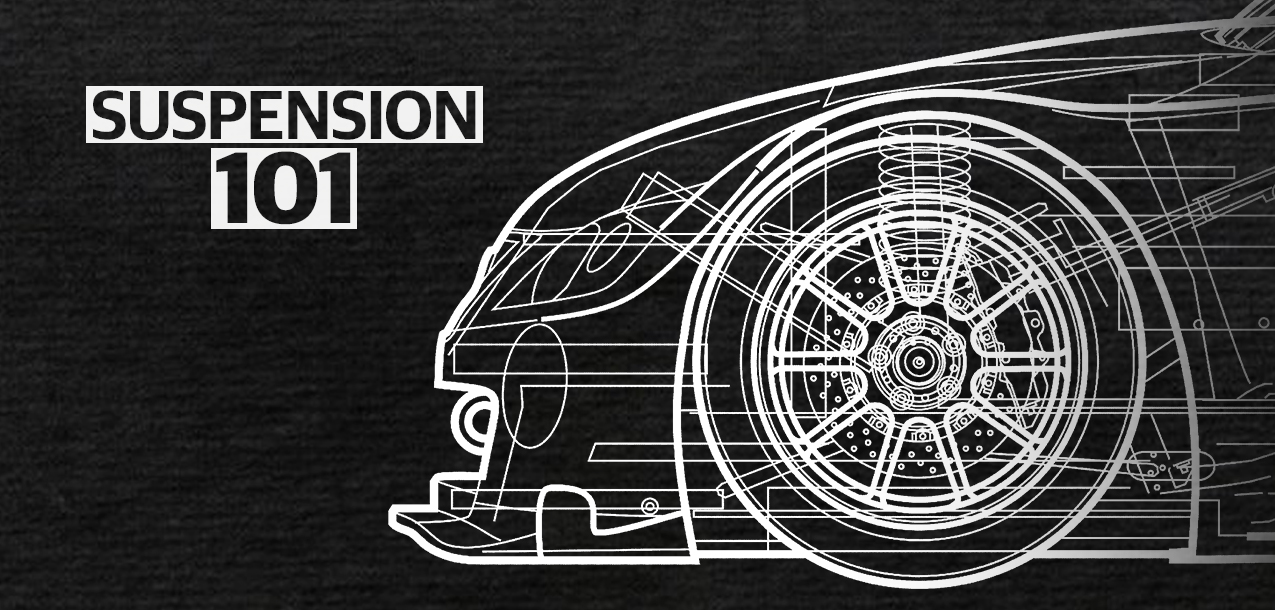
Making your car handle well is a really complicated task if you overthink it. Ride frequencies, roll centers, camber curves, scrub radii; it’s enough to make you build show cars instead. So, I have an easy solution for you: ignore all of that stuff. Odds are that you can make your car handle better than most by knowing the following five things.
Text by Dave Coleman // Photos by DSPORT Staff
DSPORT Issue #148

Number One: Tires
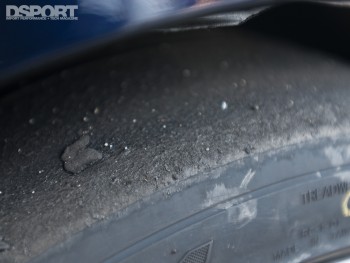
What about treadwear rating? You might be thinking, “Isn’t a tire with a treadwear rating of 40 far grippier than one with a 400?” That’s probably true. The treadwear rating is a decent indicator of a tire’s performance capability, but don’t nitpick it. A 160 treadwear is not necessarily stickier than a 200. The more modern a tire design, the higher its treadwear rating can be while still being sticky. In fact, the Uniform Tire Quality Grade Standards (UTQG) treadwear rating is actually the minimum treadwear of that specific tire. It’s at the manufacturer’s discretion whether they want to classify a high performance tire as a “100” treadwear tire for marketing purposes even though it may offer enough tread life to be comparable to a “200” treadwear tire. Don’t waste your time comparing treadwear ratings between manufacturers, as every tire company hires its own independent testing company to conduct the tire tests. Unless any inconsistencies come up in the final data, the Department of Transporation doesn’t bother to regulate.
In the end, experience is the best tool for picking a tire. If you don’t have enough experience, use somebody else’s. See who is fast at the track and ask what tires they like, and why.
Number Two: Travel
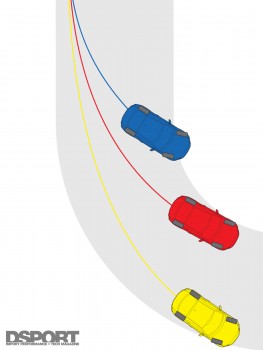
Having enough suspension travel is almost as important as having good tires. Think about this when you’re fantasizing about how low you want your car to be. Some cars, like the old double-wishbone Civics, have so much travel that you can be in the weeds and still have plenty of travel. Others, like the MAZDASPEED3, can hardly be lowered at all before they start pounding the bump stops.
How much travel you need is determined partly by the terrain you’re driving on and partly by your suspension setup. Having stiffer springs means your suspension will move less, so you don’t need as much travel. The same is true if you have a lot of low-speed damping from your shocks. The next item might not be so obvious: you’ll need more travel and/or a stiffer suspension if you have really sticky tires. The reason is simple; more grip on the road means more body roll, which uses up more travel.
There are ways to maximize the amount of usable suspension travel range that involve adding more parts and making more changes to the entire system to balance out all the other dynamic factors. The simplest travel solution, though, is simply not to lower your car so much.
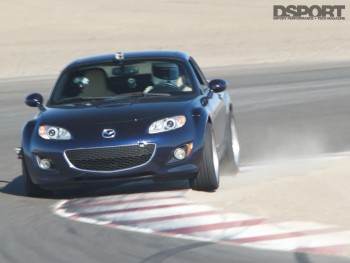
The red Miata shows excessive body roll with factory suspension. The blue Miata equipped with coilovers shows reduced body roll.
Article continued on page 2 >>>.
Advertisement
How Car Suspensions Work
- Share Content on Facebook
- Share Content on LinkedIn
- Share Content on Flipboard
- Share Content on Reddit
- Share Content via Email
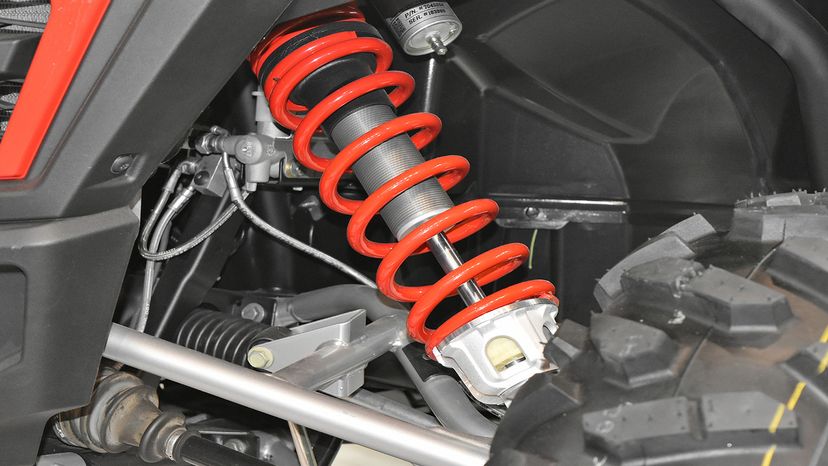
When people think of automobile performance, they normally think of horsepower , torque and zero-to-60 acceleration. But all of the power generated by a piston engine is useless if the driver can't control the car. That's why automobile engineers turned their attention to the suspension system almost as soon as they had mastered the four-stroke internal combustion engine.
The job of a car suspension is to maximize the friction between the tires and the road surface, to provide steering stability with good handling and to ensure the comfort of the passengers. In this article, we'll explore how car suspensions work, how they've evolved over the years and where the design of suspensions is headed in the future.
If a road was perfectly flat, with no irregularities, suspensions wouldn't be necessary. But roads are far from flat. Even freshly paved highways have subtle imperfections that can interact with the wheels of a car. It's these imperfections that apply forces to the wheels. According to Newton's Laws of Motion , all forces have both magnitude and direction . A bump in the road causes the wheel to move up and down perpendicular to the road surface. The magnitude, of course, depends on whether the wheel is striking a giant bump or a tiny speck. Either way, the car wheel experiences a vertical acceleration as it passes over an imperfection.
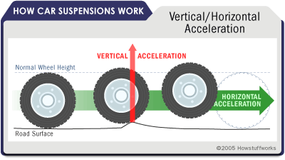
Without an intervening structure, all of the wheel's vertical energy is transferred to the frame, which moves in the same direction. In such a situation, the tires can lose contact with the road completely. Then, under the downward force of gravity , the tires can slam back into the road surface. What you need is a system that will absorb the energy of the vertically accelerated wheel, allowing the frame and body to ride undisturbed while the tires follow bumps in the road.
The study of the forces at work on a moving car is called vehicle dynamics , and you need to understand some of these concepts in order to appreciate why a suspension is necessary in the first place. Most automobile engineers consider the dynamics of a moving car from two perspectives:
- Ride : a car's ability to smooth out a bumpy road
- Handling : a car's ability to safely accelerate, brake and corner
These two characteristics can be further described in three important principles — road isolation , road holding and cornering . The table below describes these principles and how engineers attempt to solve the challenges unique to each.
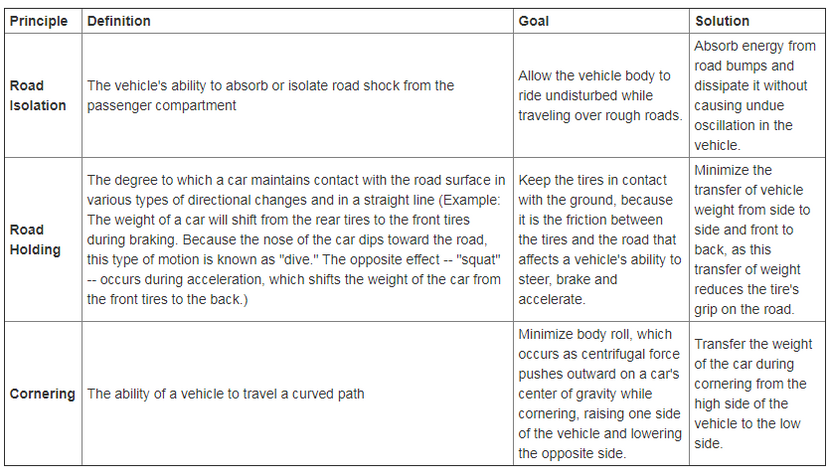
A car's suspension, with its various components, provides all of the solutions described.
Let's look at the parts of a typical suspension, working from the bigger picture of the chassis down to the individual components that make up the suspension proper.
Car Suspension Parts
Dampers: shock absorbers, dampers: struts and sway bars, suspension types: front, suspension types: rear, specialized suspensions: the baja bug, specialized suspensions: formula one racers, specialized suspensions: hot rods.
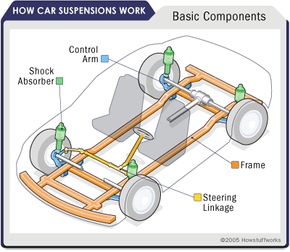
The suspension of a car is actually part of the chassis, which comprises all of the important systems located beneath the car's body. These systems include:
- The frame : structural, load-carrying component that supports the car's engine and body, which are in turn supported by the suspension
- The suspension system : setup that supports weight, absorbs and dampens shock and helps maintain tire contact
- The steering system : mechanism that enables the driver to guide and direct the vehicle
- The tires and wheels : components that make vehicle motion possible by way of grip and/or friction with the road
So the suspension is just one of the major systems in any vehicle.
With this big-picture overview in mind, it's time to look at the three fundamental components of any suspension: springs, dampers and sway bars.
Today's springing systems are based on one of four basic designs:
- Coil springs are the most common type of spring and is, in essence, a heavy-duty torsion bar coiled around an axis. Coil springs compress and expand to absorb the motion of the wheels.
- Leaf springs consist of several layers of metal (called "leaves") bound together to act as a single unit. Leaf springs were first used on horse-drawn carriages and were found on most American automobiles until 1985. They are still used today on most trucks and heavy-duty vehicles.
- Torsion bars use the twisting properties of a steel bar to provide coil-spring-like performance. This is how they work: One end of a bar is anchored to the vehicle frame. The other end is attached to a wishbone, which acts like a lever that moves perpendicular to the torsion bar. When the wheel hits a bump, vertical motion is transferred to the wishbone and then, through the levering action, to the torsion bar. The torsion bar then twists along its axis to provide the spring force. European carmakers used this system extensively, as did Packard and Chrysler in the United States, through the 1950s and 1960s.
- Air springs consist of a cylindrical chamber of air positioned between the wheel and the car's body, and use the compressive qualities of air to absorb wheel vibrations. The technology is used in many luxury vehicles today, but the concept is actually more than a century old and could be found on horse-drawn buggies. Air springs from this era were made from air-filled, leather diaphragms, much like a bellows; they were replaced with molded-rubber air springs in the 1930s.
Based on where springs are located on a car — i.e., between the wheels and the frame — engineers often find it convenient to talk about the sprung mass and the unsprung mass .
Springs: Sprung and Unsprung Mass
The sprung mass is the mass of the vehicle supported on the springs, while the unsprung mass is loosely defined as the mass between the road and the suspension springs. The stiffness of the springs affects how the sprung mass responds while the car is being driven. Loosely sprung cars, such as luxury cars (think Mercedes-Benz C-Class), can swallow bumps and provide a super-smooth ride; however, such a car is prone to dive and squat during braking and acceleration and tends to experience body sway or roll during cornering. Tightly sprung cars, such as sports cars (think Mazda Miata MX-5), are less forgiving on bumpy roads, but they minimize body motion well, which means they can be driven aggressively, even around corners.
So, while springs by themselves seem like simple devices, designing and implementing them on a car to balance passenger comfort with handling is a complex task. And to make matters more complex, springs alone can't provide a perfectly smooth ride. Why? Because springs are great at absorbing energy, but not so good at dissipating it. Other structures, known as dampers , are required to do this.
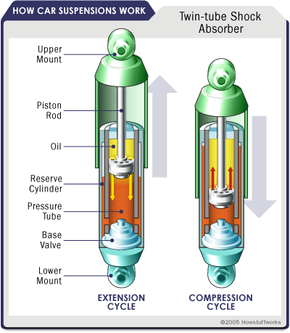
Unless a dampening structure is present, a car spring will extend and release the energy it absorbs from a bump at an uncontrolled rate. The spring will continue to bounce at its natural frequency until all of the energy originally put into it is used up. A suspension built on springs alone would make for an extremely bouncy ride and, depending on the terrain, an uncontrollable car.
Enter the shock absorber , or snubber, a device that controls unwanted spring motion through a process known as dampening . Shock absorbers slow down and reduce the magnitude of vibratory motions by turning the kinetic energy of suspension movement into heat energy that can be dissipated through hydraulic fluid. To understand how this works, it's best to look inside a shock absorber to see its structure and function.
A shock absorber is basically an oil pump placed between the frame of the car and the wheels. The upper mount of the shock connects to the frame (i.e., the sprung weight), while the lower mount connects to the axle, near the wheel (i.e., the unsprung weight). In a twin-tube design , one of the most common types of shock absorbers, the upper mount is connected to a piston rod, which in turn is connected to a piston, which in turn sits in a tube filled with hydraulic fluid. The inner tube is known as the pressure tube, and the outer tube is known as the reserve tube. The reserve tube stores excess hydraulic fluid.
When the car wheel encounters a bump in the road and causes the spring to coil and uncoil, the energy of the spring is transferred to the shock absorber through the upper mount, down through the piston rod and into the piston. Holes perforate the piston and allow fluid to leak through as the piston moves up and down in the pressure tube. Because the holes are relatively tiny, only a small amount of fluid, under great pressure, passes through. This slows down the piston, which in turn slows down the spring.
Shock absorbers work in two cycles — the compression cycle and the extension cycle . The compression cycle occurs as the piston moves downward, compressing the hydraulic fluid in the chamber below the piston. The extension cycle occurs as the piston moves toward the top of the pressure tube, compressing the fluid in the chamber above the piston. A typical car or light truck will have more resistance during its extension cycle than its compression cycle. With that in mind, the compression cycle controls the motion of the vehicle's unsprung weight, while extension controls the heavier, sprung weight.
All modern shock absorbers are velocity-sensitive — the faster the suspension moves, the more resistance the shock absorber provides. This enables shocks to adjust to road conditions and to control all of the unwanted motions that can occur in a moving vehicle, including bounce, sway, brake dive and acceleration squat.
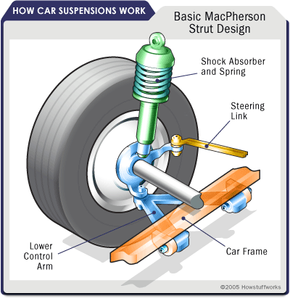
Another common dampening structure is the strut — basically a shock absorber mounted inside a coil spring. Struts perform two jobs: They provide a dampening function like shock absorbers, and they provide structural support for the vehicle suspension. That means struts deliver a bit more than shock absorbers, which don't support vehicle weight — they only control the speed at which weight is transferred in a car, not the weight itself.
Because shocks and struts have so much to do with the handling of a car, they can be considered critical safety features. Worn shocks and struts can allow excessive vehicle-weight transfer from side to side and front to back. This reduces the tire's ability to grip the road, as well as handling and braking performance.
Sway bars (also known as anti-roll bars) are used along with shock absorbers or struts to give a moving automobile additional stability. A sway bar is a metal rod that spans the entire axle and effectively joins each side of the suspension together.
When the suspension at one wheel moves up and down, the sway bar transfers movement to the other wheel. This creates a more level ride and reduces vehicle sway . In particular, it combats the roll of a car on its suspension as it corners. For this reason, almost all cars today are fitted with sway bars as standard equipment, although if they're not, kits make it easy to install the bars at any time.
So far, our discussions have focused on how springs and dampers function on any given wheel. But the four wheels of a car work together in two independent systems — the two wheels connected by the front axle and the two wheels connected by the rear axle. That means that a car can and usually does have a different type of suspension on the front and back.
Much is determined by whether a rigid axle binds the wheels or if the wheels are permitted to move independently. The former arrangement is known as a dependent system , while the latter arrangement is known as an independent system . In the following sections, we'll look at some of the common types of front and back suspensions typically used on mainstream cars.
Dependent Front Suspensions
Dependent front suspensions have a rigid front axle that connects the front wheels. Basically, this looks like a solid bar under the front of the car, kept in place by leaf springs and shock absorbers. Common on trucks, dependent front suspensions haven't been used in mainstream cars for years.
Independent Front Suspensions
In this setup, the front wheels are allowed to move independently. The MacPherson strut , developed by Earle S. MacPherson of General Motors in 1947, is the most widely used front suspension system, especially in cars of European origin.
The MacPherson strut combines a shock absorber and a coil spring into a single unit. This provides a more compact and lighter suspension system that can be used for front-wheel drive vehicles.
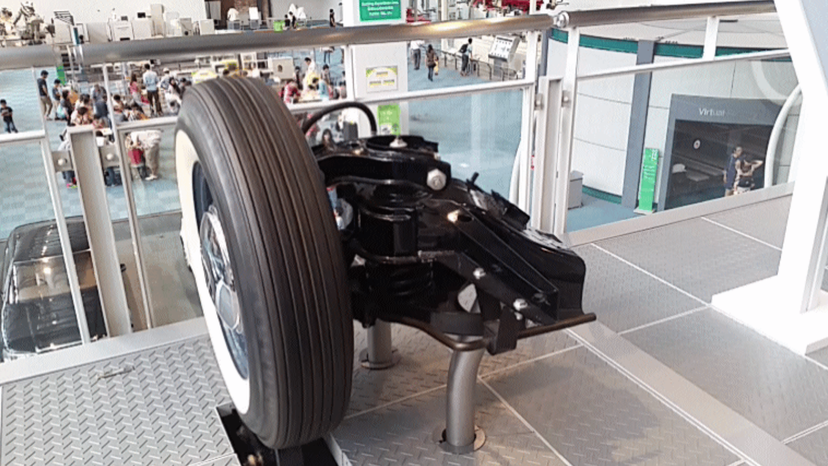
The double-wishbone suspension , also known as an A-arm suspension or control-arm suspension, is another common type of front independent suspension.
While there are several different possible configurations, this design typically uses two wishbone-shaped arms to locate the wheel. Each wishbone, which has two mounting positions to the frame and one at the wheel, bears a shock absorber and a coil spring to absorb vibrations. Double-wishbone suspensions allow for more control over the camber angle of the wheel, which describes the degree to which the wheels tilt in and out. They also help minimize roll or sway and provide for a more consistent steering feel. Because of these characteristics, the double-wishbone suspension is common on the front wheels of larger cars.
Now let's look at some common rear suspensions.
Dependent Rear Suspensions
If a solid axle connects the rear wheels of a car, then the suspension is usually quite simple — based either on a leaf spring or a coil spring. In the former design, the leaf springs clamp directly to the drive axle. The ends of the leaf springs attach directly to the frame, and the shock absorber is attached at the clamp that holds the spring to the axle. For many years, American car manufacturers preferred this design because of its simplicity.
The same basic design can be achieved with coil springs replacing the leaves. In this case, the spring and shock absorber can be mounted as a single unit or as separate components. When they're separate, the springs can be much smaller, which reduces the amount of space the suspension takes up.
Independent Rear Suspensions
If both the front and back suspensions are independent, then all of the wheels are mounted and sprung individually, resulting in what car advertisements tout as "four-wheel independent suspension." Any suspension that can be used on the front of the car can be used on the rear, and versions of the front independent systems described in the previous section can be found on the rear axles. Of course, in the rear of the car, the steering rack — the assembly that includes the pinion gear wheel and enables the wheels to turn from side to side — is absent. This means that rear independent suspensions can be simplified versions of front ones, although the basic principles remain the same.
Next, we'll look at the suspensions of specialty cars.
Sixteenth-century wagons and carriages tried to solve the problem of "feeling every bump in the road" by slinging the carriage body from leather straps attached to four posts of a chassis that looked like an upturned table. Because the carriage body was suspended from the chassis, the system came to be known as a "suspension" — a term still used today to describe the entire class of solutions. The slung-body suspension was not a true springing system, but it did enable the body and the wheels of the carriage to move independently. Semi-elliptical spring designs, also known as cart springs, quickly replaced the leather-strap suspension. Popular on wagons, buggies and carriages, the semi-elliptical springs were often used on both the front and rear axles. They did, however, tend to allow forward and backward sway and had a high center of gravity. By the time powered vehicles hit the road, other, more efficient springing systems were being developed to smooth out the ride for passengers.
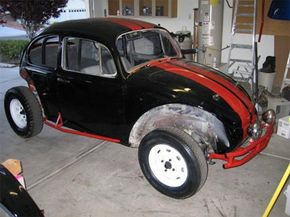
For the most part, this article has focused on the suspensions of mainstream front- and rear-wheel-drive cars — cars that drive on normal roads in normal driving conditions. But what about the suspensions of specialty cars, such as hot rods, racers or extreme off-road vehicles? Although the suspensions of specialty autos obey the same basic principles, they do provide additional benefits unique to the driving conditions they must navigate. What follows is a brief overview of how suspensions are designed for three types of specialty cars — Baja Bugs, Formula One racers and American-style hot rods.
The Volkswagen Beetle, or Bug, was destined to become a favorite among off-road enthusiasts. With a low center of gravity and engine placement over the rear axle, the two-wheel-drive Bug handles off-road conditions as well as some four-wheel-drive vehicles. Of course, the VW Bug isn't ready for off-road conditions with its factory equipment. Most Bugs require some modifications, or conversions, to get them ready for racing in harsh conditions like the deserts of Baja California.
One of the most important modifications takes place in the suspension. The torsion-bar suspension, standard equipment on the front and back of most Bugs between 1936 and 1977, can be raised to make room for heavy-duty, off-road wheels and tires. Longer shock absorbers replace the standard shocks to lift the body higher and to provide for maximum wheel travel. In some cases, Baja Bug converters remove the torsion bars entirely and replace them with multiple coil-over systems , an aftermarket item that combines both the spring and shock absorber in one adjustable unit. The result of these modifications is a vehicle that allows the wheels to travel vertically 20 inches (50 centimeters) or more at each end. Such a car can easily navigate rough terrain and often appears to "skip" over desert washboard like a stone over water.
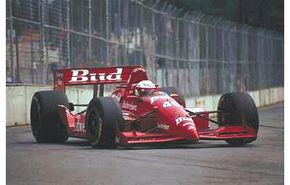
The Formula One racing car represents the pinnacle of automobile innovation and evolution. Lightweight, composite bodies, powerful V10 engines and advanced aerodynamics have led to faster, safer and more reliable cars.
To elevate driver skill as the key differentiating factor in a race, stringent rules and requirements govern Formula One racecar design. For example, the rules regulating suspension design say that all Formula One racers must be conventionally sprung, but they don't allow computer-controlled, active suspensions. To accommodate this, the cars feature multi-link suspensions , which use a multi-rod mechanism equivalent to a double-wishbone system.
Recall that a double-wishbone design uses two wishbone-shaped control arms to guide each wheel's up-and-down motion. Each arm has three mounting positions — two at the frame and one at the wheel hub — and each joint is hinged to guide the wheel's motion. In all cars, the primary benefit of a double-wishbone suspension is control . The geometry of the arms and the elasticity of the joints give engineers ultimate control over the angle of the wheel and other vehicle dynamics, such as lift, squat and dive.
Unlike road cars, however, the shock absorbers and coil springs of a Formula One racecar don't mount directly to the control arms. Instead, they are oriented along the length of the car and are controlled remotely through a series of push and pull rods. They translate the up-and-down motions of the wheel to the back-and-forth movement of the spring-and-damper apparatus.
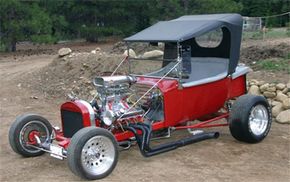
The classic American hot rod era lasted from 1945 to about 1965. Like Baja Bugs, classic hot rods required significant modification by their owners. Unlike Bugs, however, which are built on Volkswagen chassis, hot rods were built on a variety of old, often historical, car models: Cars manufactured before 1945 were considered ideal fodder for hot rod transformations because their bodies and frames were often in good shape, while their engines and transmissions needed to be replaced completely. For hot rod enthusiasts, this was exactly what they wanted, for it allowed them to install more reliable and powerful engines, such as the flathead Ford V8 or the Chevrolet V8.
One popular hot rod was known as the T-bucket because it was based on the Ford Model T. The stock Ford suspension on the front of the Model T consisted of a solid I-beam front axle (a dependent suspension), a U-shaped buggy spring (leaf spring) and a wishbone-shaped radius rod with a ball at the rear end that pivoted in a cup attached to the transmission.
Ford's engineers built the Model T to ride high with a large amount of suspension movement, an ideal design for the rough, primitive roads of the 1930s. But after World War II, hot rodders began experimenting with larger Cadillac or Lincoln engines, which meant that the wishbone-shaped radius rod was no longer applicable. Instead, they removed the center ball and bolted the ends of the wishbone to the framerails. This " split wishbone " design lowered the front axle about 1 inch (2.5 centimeters) and improved vehicle handling.
Lowering the axle more than an inch required a brand-new design, which was supplied by a company known as Bell Auto. Throughout the 1940s and 1950s, Bell Auto offered dropped tube axles that lowered the car a full 5 inches (13 centimeters). Tube axles were built from smooth steel tubing and balanced strength with superb aerodynamics. The steel surface also accepted chrome plating better than the forged I-beam axles, so hot rodders often preferred them for their aesthetic qualities, as well.
Some hot rod enthusiasts, however, argued that the tube axle's rigidity and inability to flex compromised how it handled the stresses of driving. To accommodate this, hot rodders introduced the four-bar suspension , using two mounting points on the axle and two on the frame. At each mounting point, aircraft-style rod ends provided plenty of movement at all angles. The result? The four-bar system improved how the suspension worked in all sorts of driving conditions.
For more information on car suspensions and related topics, check out the links below.
Car Suspension FAQ
What does suspension do for a car, what are the parts of a car suspension, how long do car suspensions last, what causes car suspension problems, how do you know if your suspension is damaged, lots more information, related articles.
- How Car Engines Work
- How Car Steering Works
- How Champ Cars Work
- How Differentials Work
- How NASCAR Race Cars Work
More Great Links
- Car Bibles: Complete Guide to Car Suspension
- Monroe Shocks and Struts Tech Support
- Samarins.com: How to check car suspension and steering when buying a used car
- "Bose suspension." Edmunds.com, Inside Line. Accessed April 26, 2005.
- http://www.cars.com/carsapp/national/?szc Cars.com Glossary Double wishbone suspension.
- Clynes, Tom. 2004 Better living through curiosity. Popular Science. December 3.
- DiPietro, John. 2004. http://www.edmunds.com/insideline/do/Features/articleId"
- http://www.edmunds.com/insideline/do/Features/articleId" Encyclopedia Britannica 2005, s.v. "damping." CD-ROM, 2005.
- http://www.edmunds.com/insideline/do/Features/articleId"Kahn, Dan. http://www.monroe.com/tech_support/tec_default.asp http://www.rodandcustommagazine.com/techarticles/135_0312_solid/ Monroe Shocks and Struts. Tech Support, Technical Training.
- Sherman, Don. http://www.automobilemag.com/news/0411_praxis/%0A
- Wright, Michael and Mukul Patel, eds. 2000. Scientific American: How things work today. New York: Crown Publishers.
Please copy/paste the following text to properly cite this HowStuffWorks.com article:
Understanding Your Car Suspension Setup
Do you know how your car's suspension system works?
What is car suspension? It seems like a silly question because you already know that suspension is the bit that connects the wheel to the vehicle. And if you're even more of a car nerd, you'll be able to identify and name all the different components. But vehicle suspension is a topic that creates almost as many arguments as gas vs diesel or a V-engine configuration versus an inline layout . So in this discussion, we'll look at stiff suspension vs soft suspension and which is best; but before we get there, we first need to understand how complex this topic actually is.
Here's an abbreviated version of the history: Man invents the wheel. Or woman invents the wheel. We don't actually know because it predates recorded history. Man then connects two wheels with a log and invents a solid axle. Put a few pieces of wood between the two, and presto - the wagon was born. Then another wagon was built, and racing was born. Only kidding.
In any case, it took a few hundred years for man to realize that connecting the body directly to the axle was a bad idea. Every bump the wooden wheels were subjected to reverberated straight through the entire cart. The first solution for this problem was to use chains to hang the frame from the axles. This only delayed the inevitable knock that would follow, so man came up with leaf springs. Leaf springs predate the American Revolutionary War and are the most basic suspension setup still in existence today, so Fred Flintstone would probably be the only person to see this system as highly advanced.
What is a Car Suspension System?
With the above in mind, the most basic definition of suspension is a series of components connecting the wheel to the car to allow the two entities (wheel and car) to move semi-independently from each other. Basically, a way of alleviating the kinetic energy from any bump or imperfection the wheel may encounter. All of this is related to the most basic function, which is comfort. But the modern car demands a lot more than just that. A modern car's suspension is a complex system, and in most cases, consists of the following components:
- Coil springs, leaf springs, or air-based suspension
- Shock absorbers
- The rods and linkages between the components
- The bushings and joints that connect the various components
Types of Suspension
You could write a book about all of the different types of suspension setups, but we'll break it down into two main categories for this article.
- Non-independent (dependent) suspension: Basically, this is any suspension where the wheels are connected via a single solid axle. What happens to one wheel will affect the other. The best modern example of this is the Jeep Wrangler , which has solid Dana axles front and rear. Jeep still uses this setup because of its inherent toughness and fundamental physics. When the wheel on the right side is pushed up, the wheel on the left is forced down. As you can imagine, this makes for epic articulation, which makes it such a good off-roader.
- Independent suspension: There are various examples of independent suspension, with MacPherson Struts, multi-link, and double wishbones being the most common. The main difference between an independent setup and a non-independent setup is that all four cars' wheels are treated as independent entities. What happens at one corner will not affect the other. Cost is most often the deciding factor when it comes to which of the above a manufacturer uses. MacPherson struts are relatively straightforward and cheap to manufacture. A multi-link setup is any suspension setup with three or more lateral bars (arms) and one lateral bar. Manufacturers can add more than one lateral bar as well. There isn't a single standard setup, which manufacturers tend to design in-house depending on the car's needs.
Different Suspension System Settings
As mentioned earlier, the Jeep Wrangler Rubicon uses solid Dana 44 axles because they're arguably the best, most cost-effective solution for off-road vehicles. The same goes for leaf springs, which you'll find at the rear suspension of most pickup trucks on sale in the USA. At the front, they'll have an independent setup, which is why you'll often hear the term semi-independent suspension.
Suspension settings depend entirely on the purpose of a car. Something as mundane as a Volkswagen Golf will use a McPherson strut at the front because it's cheap to mass manufacture yet adaptable enough to offer both comfort and the necessary grip levels. Even the VW Golf GTI uses this setup at the front and a multi-link setup at the rear. This provides the best of both worlds, as it can be both comfortable and sporty. Thanks to the invention of adaptive damping and air suspension, drivers can now choose how they want the suspension to react, but more on that later.
Most drivers want soft shocks or a soft suspension. This is easy enough to provide these days with independent options like the McPherson strut and double-wishbone suspension. A perfect example of this comfort-first approach is a luxury car like the Lexus ES. The front suspension is a MacPherson strut placed at an angle to provide a smooth ride. At the rear, it has a trailing arm with a high mounting point, which allows for a larger bushing size. All of this means the Lexus glides down the road as syrup runs down a hot pancake.
Higher up in the chain, you have some seriously advanced comfort-biased suspension setups. Manufacturers struggled with air when it first came along, but over the years, this system has been refined to a point where it's now virtually the gold standard in the luxury barge segment.
For a prime example, look no further than the all-new 2022 Mercedes-Benz S-Class . As standard, it has an air suspension system and active suspension dampers. The former is simply there to carry the body's load, while the latter is connected to a 48-volt system that can change the damping rate at all four wheels. Let's say the new rear-wheel-drive S-Class is accelerating from a standing start. Usually, the car's nose will lift slightly, while the rear hunkers down - because physics. The new S-Class can counteract this by balancing the forces at both axles. We were never bothered by the physical reaction of acceleration, as it was simply a given - like the sun coming up every morning. But along comes Merc and removes it via an intelligent suspension setup. There's also a new E-Active Body Control suspension setup that uses a camera and multiple sensors to scan the road ahead. It does this more than 1,000 times per second. Depending on the mode, it will prep the suspension for what's coming. If it detects a bump on the right side, it will prime the suspension to soak it up perfectly. In a more dynamic mode, it can firm up the right wheels for a tight left corner. Heck, it can even give the rear left wheel a bit more articulation when it starts spinning.
Stiff vs Soft Suspension: The Best Setup for Comfort and Performance
If you're wondering what suspension is better for comfort and which is better for performance, the answer is the same. A car has four independent wheels, which travel at different speeds, and are subject to various forces. That's why an independent suspension is the best for everything, including off-roading. We can hear the solid car axle and leaf spring fans moaning in the back, but for proof, look no further than the Land Rover Defender. It has a fully independent multi-link air suspension. Not only does it make it refined on the road, but the air suspension allows for impressive articulation. At the same time, the multi-link setup has greater control over lateral and longitudinal movements. Essentially, it improves grip, which is the essence of off-roading.
As we learned above from the new S-Class and Lexus ES, independent is also the perfect solution for a comfort suspension. Coupled with adaptive damping, it can also offer the best balance between comfort and performance. Take any of the current super-sedan cars out there: Mercedes-AMG E 63 S, Audi RS6 Avant, and BMW M5. All of them have adaptive damping, which allows them to be reasonably comfortable and ridiculously stiff when the mood for driving fast strikes.
For sports cars , independent also works best. A multi-link setup allows for great lateral and longitudinal control, improving grip. But the positives are not just limited to the lateral arms providing more grip. An adjustable shock absorber can be tuned to provide an effective damping rate, while a positive caster setting (the axis of the shock absorber) can increase grip. On performance SUVs, the norm is an air suspension, which allows for comfortable damping daily, but the car can also be lowered by a few inches to decrease the center of gravity.
How to Improve a Suspension Setup
If you're a casual car enthusiast who doesn't participate in track days, best stick with the standard OEM suspension. A manufacturer spent millions of dollars finding the perfect balance for your car, so best keep it that way. Since an independent suspension is such an intricate system, you can easily mess up the whole system by changing one component. A strut brace is a perfect example. It's affordable and easy enough to install, but your car's multi-link suspension's movement may be limited and damaged by the increased rigidity. A suspension swap is easy enough on a pickup with leaf springs. There are various manufacturers out there that offer adjustable shock absorbers that improve ride quality.
With the above in mind, here are some changes you can make to (hopefully) increase performance. We'll also include some pros and cons.
- Lowering springs: Theoretically, your car will sit lower to the ground, decreasing the center of gravity. On the downside, lowering the vehicle may harm other parts. It increases the risk of bottoming out and reduces the amount of lock you have in the steering. The body might be lowered to the point where it touches the wheel at full lock, which is a common occurrence. When it comes to car springs, please let the professionals do it. Using the wrong equipment can literally kill you.
- Upgrading the shock absorbers: When choosing a shock absorber, you want to consider the damping rate. A car's standard damping rate might be too slow for your liking. You want the oscillations (bounces) to disappear as quickly as possible for increased grip on an RWD performance car. On the downside, it will likely have a negative effect on ride comfort and your vehicle might become too stiff to live with daily.
- Different wheels and tires: This is the easiest, safest way to increase comfort and performance, yet it's often overlooked. Swapping the OEM tire for a grippier tire has apparent benefits. You can take it too far, however. Semi-slick tires may seem like a good idea, right up until it rains. Some suspension components also rely on the tire for a certain amount of flex and give. A grippier tire might even put too much stress on the other suspension components.
- Circle Track
- OEM/Industrial
- Full-Vehicle Suspension Kits & Systems
- Shocks, Struts & Coil-Overs
- Control Arms & Other Tubular Components
- Accessories
- Modern Truck Suspension Systems
- Classic Truck Suspension Systems
- Big Wheel Suspension
- Mopar Coil-Over Conversion Systems
- DIY Suspension Parts
Driveshafts
Merchandise.
- QA1 Merchandise
- Go Drive It Merchandise
Rod Ends & Ball Joints
- Spherical Bearings
- Racing Ball Joints
- Ball Joint Linkages
- Linkage Adjusters
- Jam Nuts, Tube Adapters & More
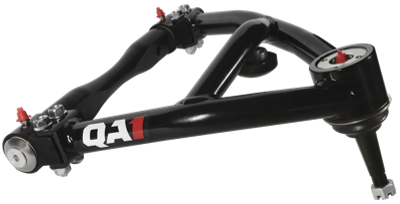
- QA1 FAQs: How Much Shock Travel Do I Need?
- 5 Things to Consider When Shopping for Drag Race Tubular Control Arms
- 5 Things to Look For In Your Pro-Touring Control Arms
- Front Suspension Tuning for Your Drag Car
- Achieve the Perfect Stance: QA1 Lowering Kit for the 2015-2020 Ford F-150
- Are Larger Sway Bars Better?
- Ball Joints 101: Frequently Asked Questions
- Why Upgrade To A Tubular K-Member?
- C10 Suspension: A Comparison Guide
- Calculating Spring Rate for QA1 Stock Mount Coil-Over Systems
- Chevy C20 Suspension System by QA1
- Coilovers vs Lowering Springs
- Coil-Over vs Torsion Bar: Suspension Upgrades for Classic Mopars
- Crown Vic Suspension Swap vs QA1's F-100 Suspension System
- Lowering Your Car: QA1 Coil-Over Shocks vs. Drop Spindles
- Cruiser, Cornering, Drag Car: How To Improve Your Impala's Suspension
- Dialing In Your Impala Suspension For The Street
- Do Tubular Trailing Arms Really Make a Noticeable Improvement?
- Driveline Angles Demystified
- GM A-Body Trailing Arms: The Upgrade Your Ride Needs
- How to Tune Your Shocks For a Smooth Ride
- Fine-Tuning Your QA1 Shocks
- Four Ways To Make Your 65-70 Impala Feel Like A New Car
- Front Suspension Tuning for Drag Racing
- How to Coyote Swap a Fox Body Mustang
- How to Determine Your Valving on QA1 Shocks
- How to Install a QA1 Mustang Tubular K-member
- How to Install QA1 GM Pro Coil Shock Systems
- How to Install C10 Front Suspension Systems
- How to Measure For Custom Shocks
- I Already Have QA1 Coil-Overs: What Should I Upgrade Next?
- Lowering your 2007-2018 Silverado / Sierra
- Making Significant Performance Gains from a Mopar Torsion Bar Suspension
- How To Measure For Custom Coil-Overs
- Mopar Suspension Upgrades: Torsion Bars vs Coil-Overs
- Muscle Car Suspension Upgrades – What to Update Now, and What Can Wait (GM)
- Mustang II Suspension & Coil-Overs FAQs
- QA1’s Dodge D100 Gets Massive Suspension Upgrades
- Rebuilding A QA1 Circle Track Twin Tube Shock
- Rebuilding A QA1 Circle Track Monotube Shock
- Shock Valving: What is Compression and Rebound?
- The Best G-Body Suspension Upgrades
- The Ultimate Guide to Updating Fox Body Mustang Suspension
- True Benefits of Tubular Control Arms
- How to Tune Your Coil-Overs For Street Driving
- Twin Tube vs Monotube Circle Track Shocks
- Tuning Your Pro Touring Car's Shocks At The Track
- Why You Should Swap Your Corvette’s Leaf Springs to Coilovers
- Upgrading Your Classic Muscle Car's Alignment: The Importance of Camber, Caster, and Toe
- Upgrading Your Chevelle Suspension in Stages
- Upgrading Your Monte Carlo Suspension in Stages
- What Does A Sway Bar Do?
- Why Coil-Overs Shouldn’t Make Your Car Ride Rough
- Why You Should Upgrade Your D100 To An Independent Front Suspension
- Street Performance & Racing FAQs
- Circle Track FAQs
- How To Order a Custom Driveshaft
- How Do I Measure My Driveshaft?
- What's My Rear Attachment?
- What’s My Transmission & Slip Yoke?
- Installation Guides
- Spring Rate Tech
- #QA1 Equipped Submissions
Shock travel: You need it, but how much and why? Ultimately, it comes down to how you’re using your vehicle. A trophy truck with crazy long travel suspension designed to soak up canyons at 100 mph will have a very different answer than an autocross car that’s sucked down to the ground.
For the sake of today’s explanation, we’re going to stick to general street cars. That means you’re using your vehicle to cruise down roads that have imperfections, railroad tracks, speed bumps, etc. Not dedicated track cars that live on the autocross, drag strip or road course. Those vehicles may require very different answers based on a number of factors, from aerodynamics to tire size and track surface.
What is shock travel?
Shock travel measures a shock’s movement through both compression and extension strokes. Compression means the shock’s piston rod is pushing up into the body of the shock, shortening (or compressing) in length. Extension is the exact opposite, meaning the piston rod is being pulled out of the body. This lengthens (or extends) the shock’s overall length.
Ultimately, you want enough travel in your shock not to top it out or bottom it out. Your shock should never be fully extended or compressed through your suspension’s full range of movement. What happens if it does? Nothing good. Not only will it give your car a rough ride, but a shock that does not have enough travel can cause performance issues and even damage your shocks or other suspension components.
How much shock travel does a street car need?
This depends on what type of suspension you have. It differs between straight axle suspensions and independent suspensions.
On straight axle suspension systems, there is a 1 to 1 ratio between the movement of your shock and your wheel. That means if your wheel moves one inch, your shock extends or compresses one inch. In these applications 2.5 inches of shock travel in both directions (compression and extension) should generally be enough.
Depending on the way your suspension is set up, you may need more. If you want to limit body roll for stiffer handling, you may want less travel than that. But even in these cases, your shock should not be thing limiting your suspension—ie being fully extended to keep the car from experiencing body roll.
For independent suspension systems, shocks do not require as much travel. That’s because the control arm acts as a lever. So, while your shock may only be moving an inch, your wheel could be traveling two inches. It could be moving three inches. It all depends on where your lower shock is located. The closer your shock is to your wheel, the closer to 1:1 that motion ratio will be.
When measuring for shock travel on an independent suspension system, start with wheel travel. Make sure it can move 2.5” in both directions. To check this, measure between your upper and lower shock mount when your suspension is fully compressed and at full droop. This will tell you how much overall stroke you’ll need to keep from bottoming out or topping out your shock.
Shock travel FAQs
What if I’m building a custom suspension setup? When setting up your own shock mounts, make sure you have a range of motion that allows enough travel. Just as importantly, make sure you can find and fit a shock that provides that much travel when extended and compressed. Any time you’re adding length, you’re adding stroke to the shock – meaning our shock will have a larger body.
How much shock stroke do I need for a street car? For straight axle applications, most cars will require a shock with five inches of stroke or so. This allows for the 2.5” of compression travel and 2.5” of extension travel mentioned above. Independent suspensions will vary depending on their design. Use the method mentioned above to measure your shock amounts and find out how much stroke is required.
Bringing it all together
We hope this helps answer some of the questions you might have about shock travel. Looking to find the right shock for your car or truck? Our tech team is happy to help. Give us a call at 952-985-5675.
- Project Cars
- Track Tests

- Buyers Guides
- Suspension and Handling

8 secrets to bending and flaring pro-quality brake lines

The 7 best cinematic car chases ever (that aren’t Ronin or Bullitt)

Can replacing the oil in a damper really improve performance?
10 common suspension problems–and how to cure them.

Looking to make your car faster? Don’t underestimate the power of suspension upgrades. Most people take their suspension cues from fellow enthusiasts–buddies or message board gurus who own a similar car. Peer acceptance of a parts combination can be quite reassuring, but can these formulas really be trusted?
Despite the hype and online chatter, sometimes you need a methodical investigation into …
This content is available for GRM+ members and Grassroots Motorsports magazine subscribers only.
You can read it for free in 146 days or subscribe to GRM+ to read right now.
Subscribe now
Already a member?
Login to read
Bottoming Out
Full-on race cars sit nice and low to the ground, so that must be good for all of us, right? Certainly a lower center of gravity pays dividends by reducing weight transfer and the associated body roll. It keeps all four tires working at higher rates of efficiency and does improve handling. Plus, it just looks cool.
But there is a dark side to skimming pavement: The car bottoms out all the time, unbeknownst to the driver. Riding around on the bumpstops can cause all manner of unusual handling. The car may be wonderful on corner entry but suddenly push like a
pig in the middle.
Riding on the bumpstops may also cause your wimpy Miata to get loose under power: The rear compresses too far and too quickly, transferring too much weight to the outside-rear wheel. And we’ve all seen the extreme case of a too-low car making like a pogo stick as it rides around town on the undamped, high spring rate offered by the bumpstop rubber.

The answer is to run the suspension through the entire range of motion without the spring attached. Verify that your bumpstops hit just before a metal-to-metal encounter between the suspension and chassis. Next, reassemble the suspension and place a zip tie on each shock absorber shaft. The zip tie will act as a telltale for suspension movement, showing exactly what’s happening.
Push down the zip tie on the shock body. Then, drive around to see whether the car is bottoming out. If it is, adjust the ride height accordingly.
So now we have a tight, stiffened, lowered car with optimal alignment and fresh parts to keep everything in line. But we’ve still got to make sure the tires are up to snuff. This is especially true when using tires that quickly go through heat cycles, like most R-compound rubber.
Worn-out tires have caused plenty of testing and competition frustration through the years. What’s worse is that it comes on slowly. In fact, the driver may not even notice how bad things are getting–that is, until a fresh set is mounted.
Tread depth is not a good indicator of tire condition, so keep a log for your tires. Track the time of use, heat cycles and so on, and you’ll quickly develop a sense for when the performance drops off and by how much. A durometer coupled with a consistent measuring technique (including temperature) can be handy as well. Don’t test on junk tires, either, as it’s a total waste of time.
Non-Optimal Alignment
Speaking of alignments, what’s yours? You’ve seen the threads a million times on message boards: “Need the best alignment for this particular make, model and so-and-so.”
Next, a bunch of people chime in with all kinds of tribal wisdom. Is it good advice? Maybe, maybe not. It depends on how closely your car’s complete setup matches the one used to determine the alignment. The two cars also need to share a similar purpose: If they both compete at the same site or track, the settings can be closer to optimal.
Those setups from the internet may get you near the ballpark, but how about some real testing using your own car? A stopwatch and skidpad will help determine optimal camber settings, while toe is found using a slalom and an oval.
Loose or Slipping Bolts and Adjusters
Once you have that optimal alignment figured out, you’re good to go, right? Wrong. If a suspension component slips under load, you’ll end up right back where you started.
Many of us are flogging older cars, and some of their parts may be far from fresh. Oftentimes, weird handling issues arise when an adjuster has some slop in it. It doesn’t take much movement to deliver positive camber or toeout in a turn. Sometimes, this is even accompanied by an audible clunk or snapping sound.

New factory adjusters and bolts are cheap insurance. Install them. You may also wish to invest in some semi-permanent threadlocking compound to keep everything in place. Paint marks can serve as indicators of movement. Finally, do pay attention to correct bolt torques. The all-too-popular PFT setting–short for pretty effing tight–is not a torque spec.
Anti-Roll Bar Bind
One of the most satisfying suspension mods involves replacing the wimpy factory anti-roll bars with some beefy aftermarket units. The car immediately feels tighter, while body roll is substantially reduced. Dynamic camber is also diminished, yielding more contact patch for better grip in the corners.
Perfect, right? Well, no.
Anti-roll bar manufacturers typically use urethane frame mounts to provide a very crisp response. Unfortunately, this creates a “bearing” surface that eventually wears out.
To avoid early complaints of knocking due to wear, the bushings provided are almost always too tight when first installed. Sure, you can lube them up to reduce some of the offending stiction, but the grease quickly gets pressed or washed out. The bar is then allowed to bind. The result: an infinite roll resistance at that end of the car that will absolutely destroy the handling.

We have two easy fixes for the common D-shaped bushings supplied with most anti-roll bars. Either grind away some material from the flat portion of the bushing or fit a washer under one or both sides of the saddle bracket. We highly recommend periodically greasing the bushings, too.
Too Much Rear Roll Stiffness in a Nose-Heavy Car
This one is the source of endless debate on message boards, especially when it comes to front- and all-wheel-drive cars. The fact of the matter is that, past a certain point, no amount of additional rear roll stiffness will affect the basic steady-state handling of the car. Period.
It may feel like it’s happening, but most of that is carryover from a cornerentry oversteer condition that’s lasting through the middle of the turn. This is especially true with short corners, like those that are only 90 degrees.
Here’s a breakdown of the physics involved: Once you’ve transferred all the weight off the inside-rear wheel, any additional weight transfer is due to cornering.
The more rear roll stiffness present, the more drastic this changeover can be. What’s worse, the point will differ depending on the grip level of the surface and tires. What may be great on concrete will be too snappy on asphalt–and totally undriveable in the wet.
Additionally, more rear stiffness will not affect body roll once past the point of total rear-weight transfer. Body roll is the result of weight transfer, and at any given lateral acceleration, only so much of that can happen at the rear. The rest will happen at the front, and the car will roll more.
Once the inside-rear starts getting light in the turns, your only method of reducing body roll is more front roll stiffness via springs or anti-roll bars. This also helps to reduce the amount of chassis flex you’re inducing with the heavy rear bias on every turn.
This is the key reason why well-balanced cars with 50/50 weight distributions–like BMWs and Miatas–handle so well and are so easy to modify to go even faster. By the way, if you have a rear weight-biased mid-engine car, take everything above and switch those two words.
Once the inside-front starts getting light in the turns, your only method of reducing body roll is
Worn-Out Parts
Although alignment parts can be among the first to go bad, plenty of other worn-out suspension components can still ruin your fun. We’ve wasted a whole day of skidpad testing thanks to a loose upper ball joint, while bad tie-rod ends and worn-out steering racks can cause dynamic toe changes. Bad wheel bearings will do strange things to camber, toe and even your brakes.
Finally, check those suspension bushings–especially when they’ve been replaced with aftermarket urethane pieces. Those urethane components typically require yearly maintenance: disassemble, clean and relube.

Rocking the steering wheel as well as the road wheels will usually uncover worn-out suspension parts. The solution is obvious: Fix what’s broken. Adding zerk grease fittings to brackets can help keep urethane bushings happy.

Too Much Shock Absorber Valving
Properly damping your new lowering springs will likely require more from your shock absorbers. That said, one size does not fit all, and too stiff is just as bad as too mushy.
We know, stiff shock absorbers do feel good. The vehicle becomes superresponsive to every input, and the driver feels totally connected to the road–that is, until they encounter a washboard and the car chatters right into a ditch. This is an extreme example, but it does show what happens when shock valving is too rigid: loss of grip.
There is a compromise between proper control of the spring rate and suppleness over the road or track surface. Optimal valving can provide both, but that may require a custom revalve.
Off-the-shelf shock absorbers can deliver the desired performance, but only if they’re used in the situations they were designed to encounter. This includes the type of activity–track, autocross, street or whatever–and the aggressiveness of the rest of the setup.
The more you optimize a component for one type of use, the worse it is at other uses. Shock absorbers are the poster child for this concept.
Useless Chassis Bracing
While this one isn’t typically a problem per se, it is a common waste of money that slows down the car. Why? Added weight.
Ever since the earliest strut cars came out, enthusiasts have been adding abrace between the strut tops. The goal is to support camber angles when loaded in a turn.
That thought process makes sense, but why do you see these braces on double A-arm cars? True, they can be beneficial in some situations, but those usually involve reducing noise, vibration and harmonics.
The car may feel better with the part installed, but does it actually perform any better? Without testing, you can’t tell. And the answer is often no.
To test a bar’s effectiveness, tightly bolt down one end while leaving the other only semi-tight. At the looser end, apply some paint between the bar and the strut top.
Excessive Bumpsteer and Ridesteer
In addition to zero suspension travel, there is another, more insidious side effect of lowering. Most production automobiles have a wide range of suspension travel, so their suspensions are designed to have benign characteristics within that scope.
However, lowering a car can easily shift the suspension into an area where the geometry does all kinds of wacky things. Massive toe changes can occur with the slightest up or down movement. Even worse, body roll can cause the car to toe in or out. Just think how horrible it would be to drive a car with a rear suspension that toes out as it rolls into a turn.
Figuring out how a chassis will act in its new, lowered state requires about an hour on an alignment rack as its suspension is moved up and down through its range of motion.

For most production cars, there’s only one way to reduce these effects: Limit the suspension movement through stiffer springs. Don’t forget to match the shock valving, too. Alternatively, you can pre-compensate for things like instability caused by excessive dynamic rear toe-out by using a large static toe-in alignment setting.
Some Parting Advice
Anything discussed here sound familiar? If so, heed our advice and you’ll save yourself a lot of frustration.
When things just don’t seem right with your car’s handling, investigate. Some problems are obvious, but others hide themselves well. Many times, the fixes are inexpensive. Check everything with our plan of attack, and you’ll be well on your way to the best driving experience ever.
More like this

5 questions to ask yourself before switching to a standalone ECU

Is a more expensive suspension setup better than an inexpensive one?

Tips for making your wheels and tires fit better

This sort of relates to 'useless chassis bracing' by making a useless brace work: I've noticed on three cars that had 100k plus on them that tightening the bejezzus out of the fastners that join the steel weldment that serves as the chassis for the dash sub assy to the cars frame firms up the steering feel, makes the car stiffness a few Hz lower, and wipes out some dash rattle & squeek for the price of a skint knuckle or two.

Don't be like some people (me). Check the preload on your springs. Lack of preload can cause some very weird handling issues, especially on diagonal corners.

In reply to jimgood :
No. The preload you're thinking of is a side effect of adjusting bump travel. You want bump travel. Preload may come as a result of that, but it's not the preload that's helping. There are a bunch of ways to prove this, the easiest of which is to change spring lengths and perch position without adjusting shock body length.
The only time preload comes into suspension tuning is on the initial movement of a fully extended wheel. That's a factor in motorcycles because they've got such insane acceleration and a high CG, but it's almost never a factor in a well set up car.

Thanks for sharing this great
My most common suspension issue is bad/loose anti-roll bar links. Usually a rattle and clunk. If it's one of the front links I can usually feel it through the pedals. Noise usually only comes when one side hits a bump and causes the bar to twist quickly over that bump. Sustained cornering doesn't cause the noise, and for whatever reason it tends to be quiet at freeway speeds.
A loose sway bar link will make noise when a lightly loaded wheel changes direction and the link goes from tension to compression and back. You won't hear it mid-corner because it's always under load, and on the freeway you don't get many sharp movements of the wheels. You're most likely to hear it in a parking lot as a rattle. Luckily, it's mostly a warning of a potential future failure and doesn't really affect handling until the parts come apart. Then you have a big increase in oversteer or understeer which can be exciting.
Heim joints/rod ends are a poor choice for sway bar links because the ends have a short lifespan, but they're common in the aftermarket because they're cheap and they're "race spec". Better to use rubber bushings or a ball joint.
Displaying 1-6 of 6 comments View all comments on the GRM forums
You'll need to log in to post.

How to build an effective splitter for only $100

How to master chassis setup, from tires pressures to alignment

14 ways to go faster without spending a dime

What you need to know before buying a lathe

3D printing: What you need to know to get started

Should you upgrade your clutch?
Our Preferred Partners

- Subscriber Services


10+ Expensive Car Repairs You Could Easily Avoid
Posted: March 28, 2024 | Last updated: March 28, 2024
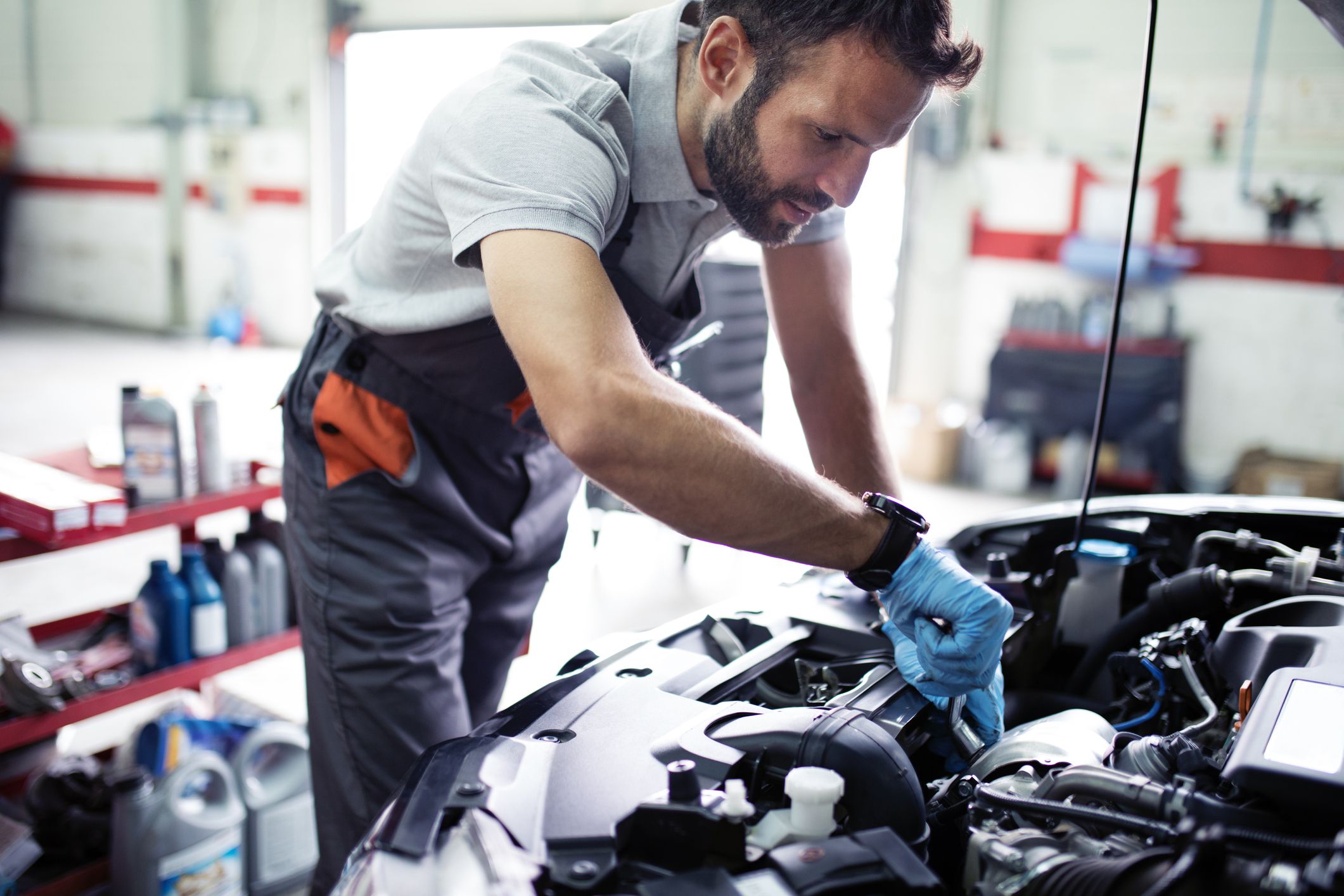
Easily avoid these auto repairs
We rely on our cars to get us to work, school, mom and dad’s house, Point A to Point B, and then some. And when they break, our world comes screeching to a halt. Not only are we without a car but saddled with costly repairs.
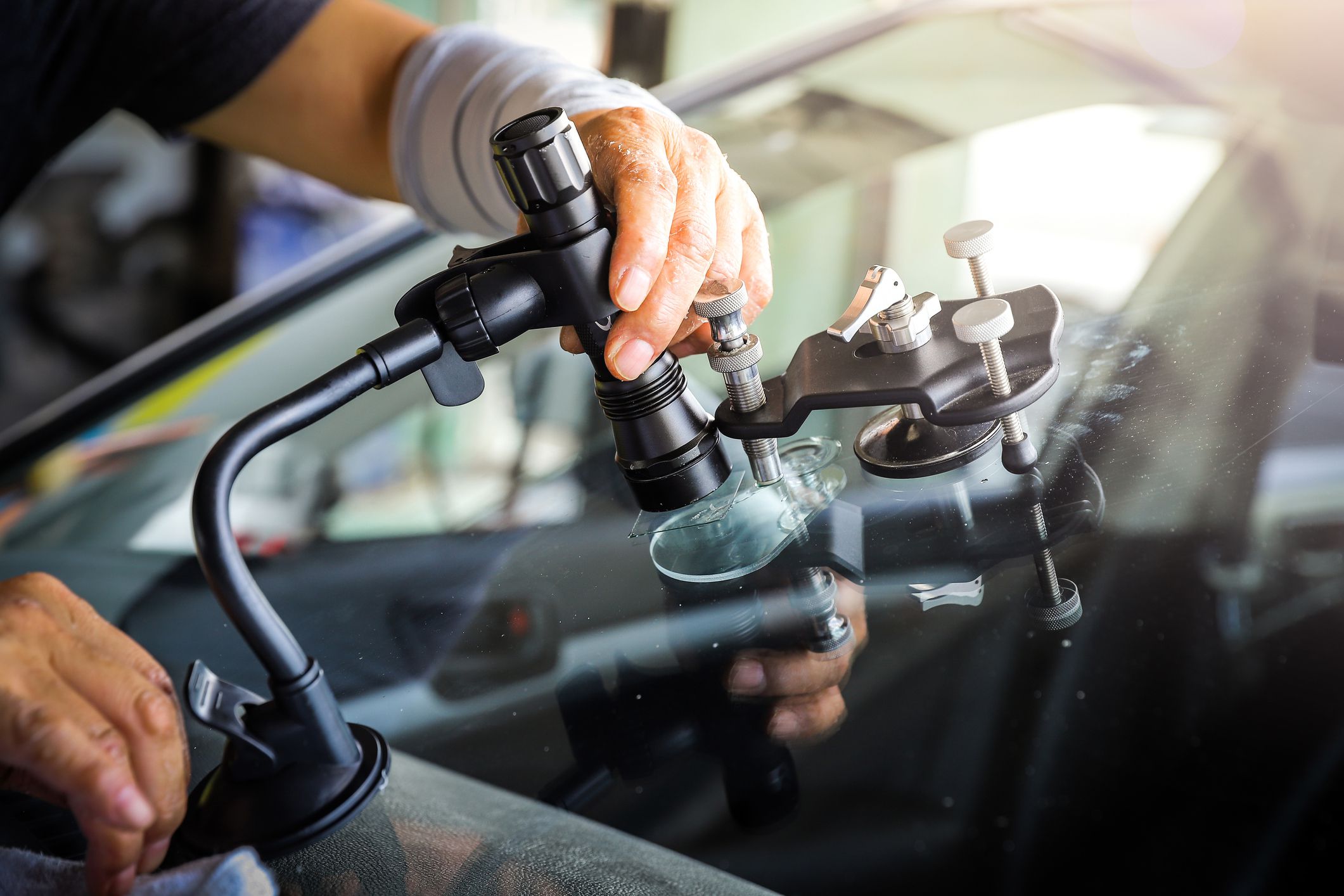
13. Windshield
How much? $300
You’re driving along and a truck kicks a rock from the road onto your windshield and cracks it. A small crack may not have to be fixed if it isn’t a hazard but oftentimes small cracks will grow with cold temperatures. If you don’t have car insurance, replacing a windshield can average $300.
Save money: Thankfully, most insurance carriers charge no more than $100 for replacement. If yours doesn't, compare other carriers who may provide better coverage at a lower price.
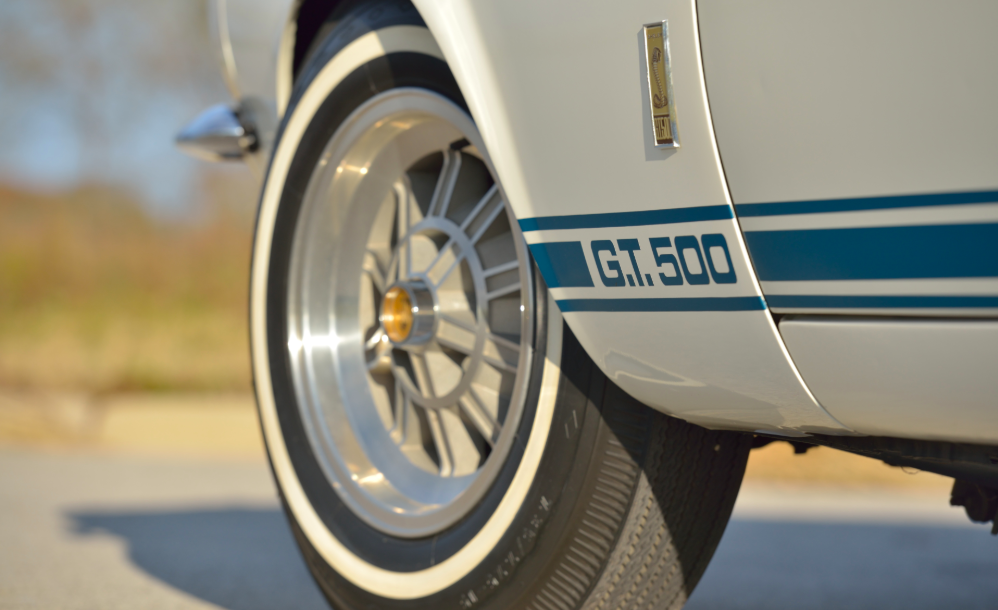
12. New tires
How much? $400
Whether you get a flat because of an object in the road or the treads of your tire have run bare, you cannot replace just one tire on your car as it will affect alignment. The cheapest tire replacement will be for two tires, with tires ranging anywhere from $50 to $300 apiece. If you need all four replaced, your budget will take a hit.
Save money: Wear and tear on your tires increases if you take curves too fast and brake too hard. Slow down and protect your tires but be sure to rotate your tires every 7,500 miles to help keep your treads balanced. Make this a regular part of your car’s maintenance.
Bonus: Better tires lead to better fuel efficiency, which can save you at the gas pump.
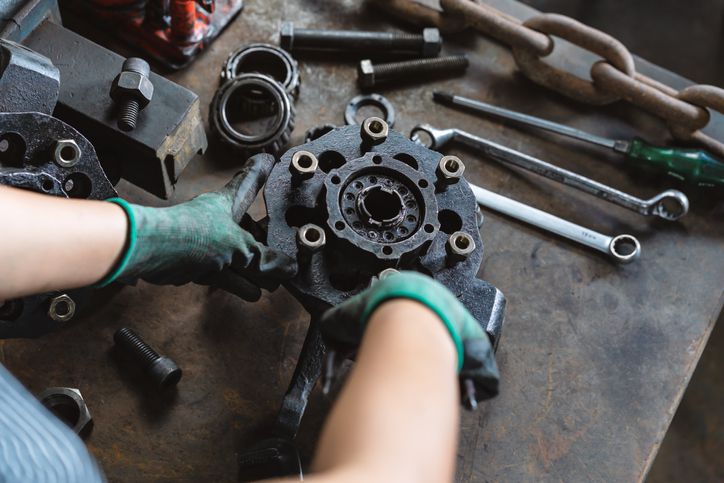
11. Air conditioner compressor replacement
How much? $500
There is nothing worse than when you lose your air conditioning on a hot summer’s day. A leading cause is a car’s air compressor. This little beauty pumps Freon into your car to keep it cool but if any part of the compressor stops working, you’ll need to replace it at the cost of around $500.
Save money: Prevention is cheaper than repairs and having your air conditioning cleaned and services at least once a year (perhaps as spring comes) can help spot issues before they become more costly.
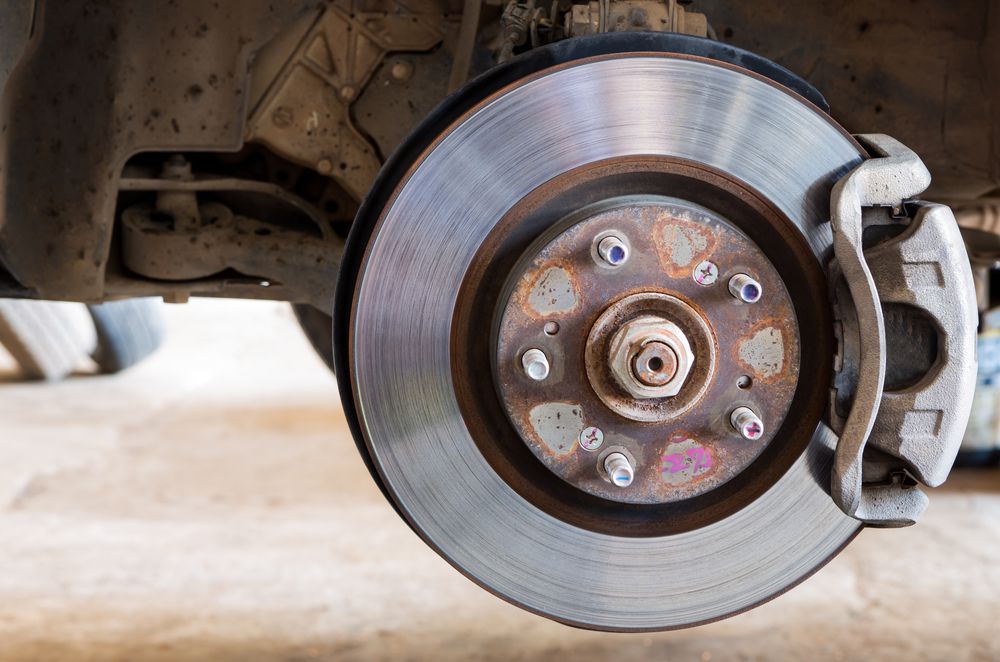
10. New brakes
If you hear your brakes squeaking, it’s your auto’s way of telling you it’s time to replace your brake pads, which can cost between $150 to $300. If you don’t take the car in, the pads could fully erode and require new rotors, which can cost $350 to $500 – on top of new pads.
Save money: A good rule of thumb is to have your brake pads replaced between 25,000 and 70,000 miles, depending on the way you drive. Replacing the pads can save you from replacing the rotors too.

9. Brake line repairs
How much? $1,000
While both brakes and rotors are not an expense you want to come out of your budget, what you don’t want to have is a broken brake line. This is what delivers brake fluid to your brakes and it shouldn’t be patched and needs to be replaced at a hefty price tag.
Save money: To ensure your brake line is running smoothly, have your brake fluid flushed every 30,000 miles. This can cost up to $120 but it’s better than $1,000!
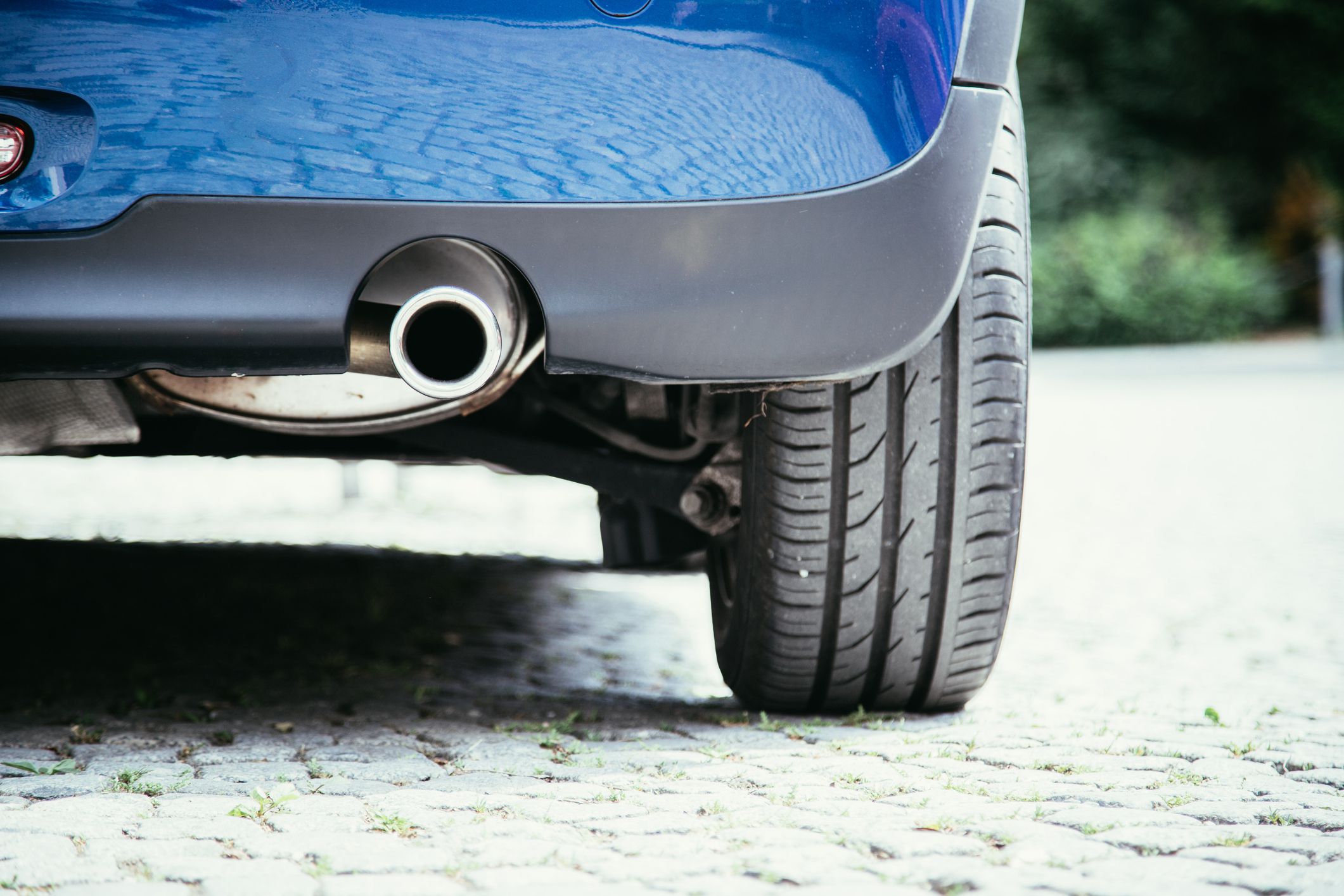
8. Catalytic converter replacement
How much? $1,500
To help keep emissions from cars lower, they are outfitted with catalytic converters that, as you may guess, convert the bad air into safer air. But if it goes, so does $1,500.
Save money: A fun way to help keep your catalytic converter from clogging is to get your car on the highway for a drive. The speed will heat up the exhaust, which will burn off any buildup.
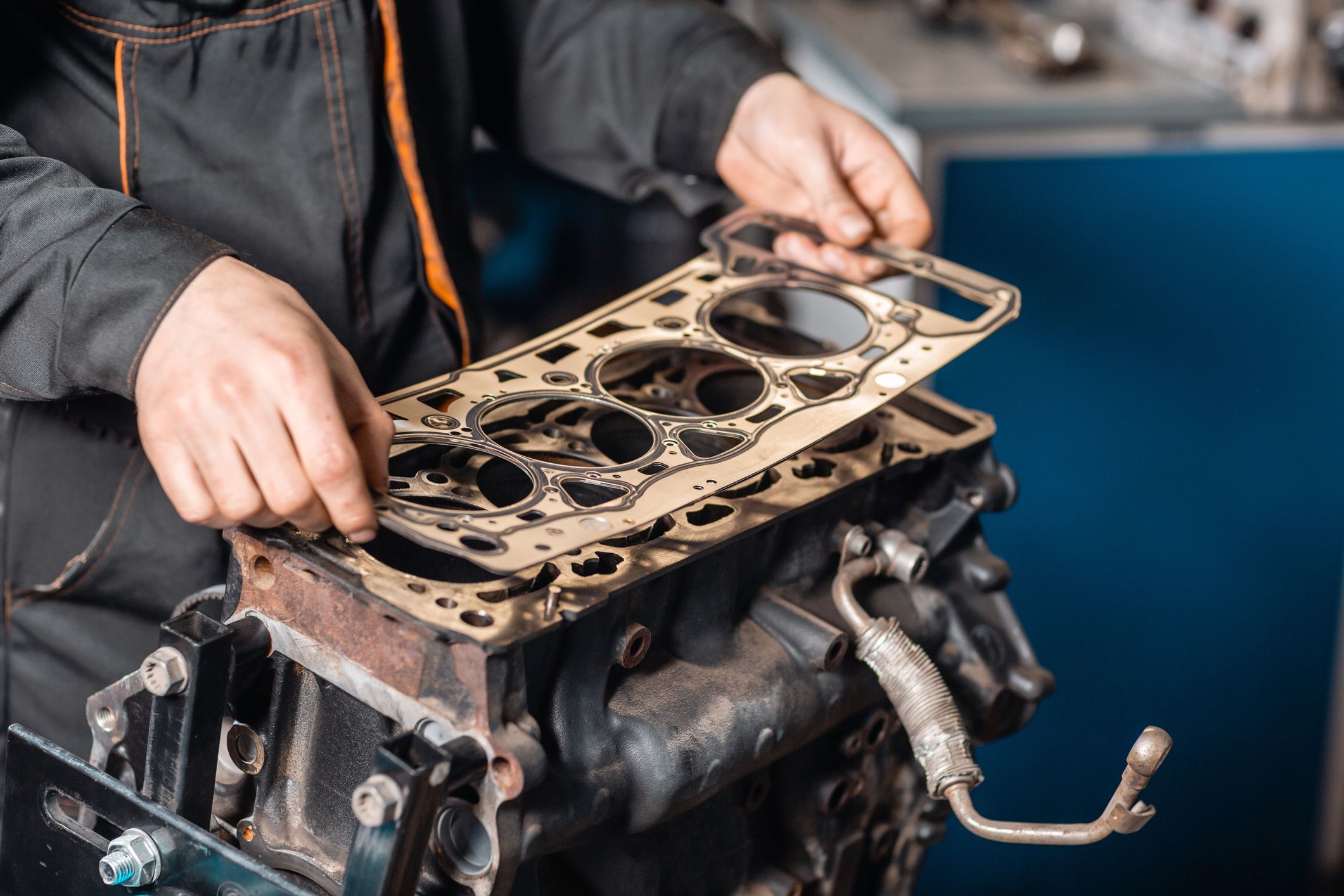
7. Head gasket replacement
How much? $2,000
How do you know if you’ve blown your gasket? Steam comes out of the engine in the car and it’s what you see in movies when someone is on the side of the road with the hood up.
This special gasket stops the car from overheating. If spotted before it blows, it’s a cheap replacement. But if you are on the side of the road with the hood up, it’s gonna cost you in labor and repairs.
Save money: Your cooling system is what keeps your car from overheating. Taking your car in for regular oil changes can help prevent issues as mechanics will look for leaks, check your radiator and top off your coolant.

6. Camshaft repair
How much? $3,000
If your valves don’t get cleaned, they can get clogged and break. The camshaft works on the air your engine gets and those clogged pipes can ruin your entire system. By the way, this is why the check engine light can come on and you should get your car checked as soon as it does.
Save money: Get your oil changed every 3,000 miles (some cars may be OK to reach every 7,500 miles). A $50 oil change every few months is much better than getting a $3,000 repair bill.
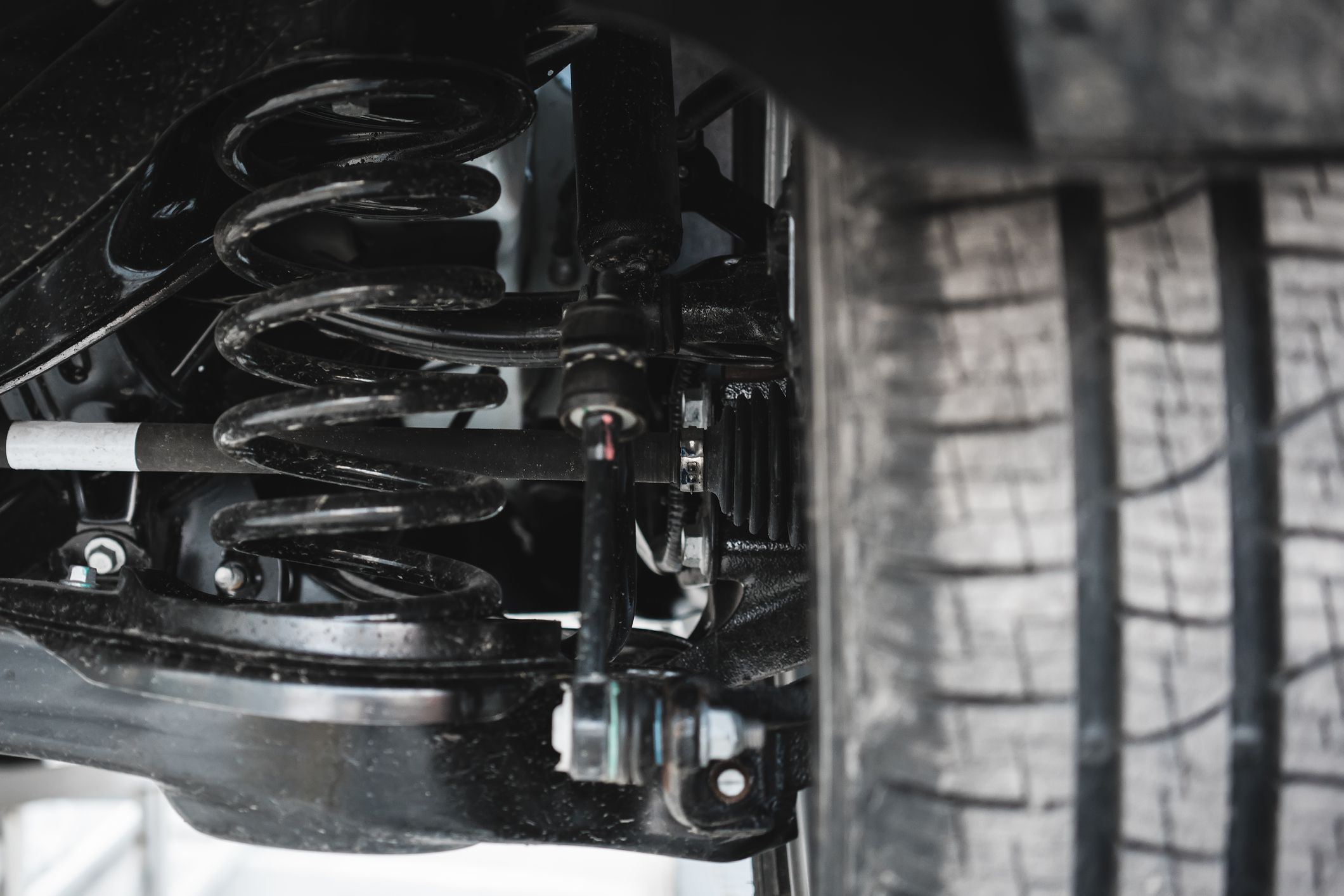
5. Suspension repairs
How much? $3,500
When your suspension system is working, it’s a smooth ride in your car. It takes shocks, struts, springs, tie rods and control arms to keep that ride smooth. If you need replacement parts, you aren’t going to like it: up to $900 to replace your struts, the most expensive of the parts. If you need an entire suspension overhaul, the repair costs add up quite a bit.
Save money: Rotating your tires also keeps your suspension aligned. You should also regularly check that your tires have the right air pressure as driving on uneven tires can mess with your suspension too. If you notice your car pulling to one side of the road, that’s time to take it into a ship.
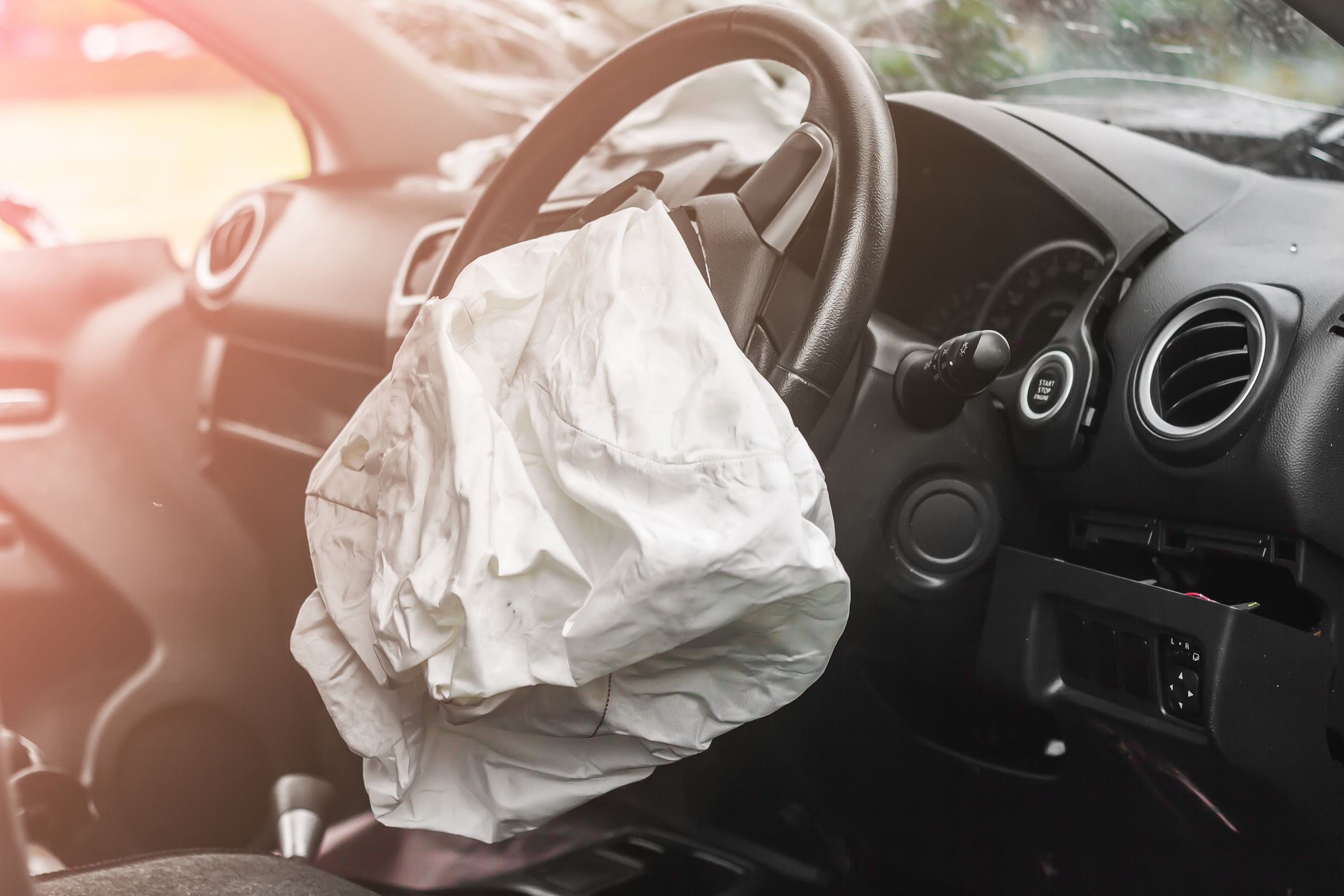
4. Airbag replacement
How much? $4,000
Your airbags are there to protect you during an accident, and when they are deployed, they need to be replaced. If you are in an accident, insurance will cover this repair but if they go off without an accident, this cost will be on you, up to $4,000 as it could include replacing the parts that hold the airbags.
Save money: Wear your seat belt!
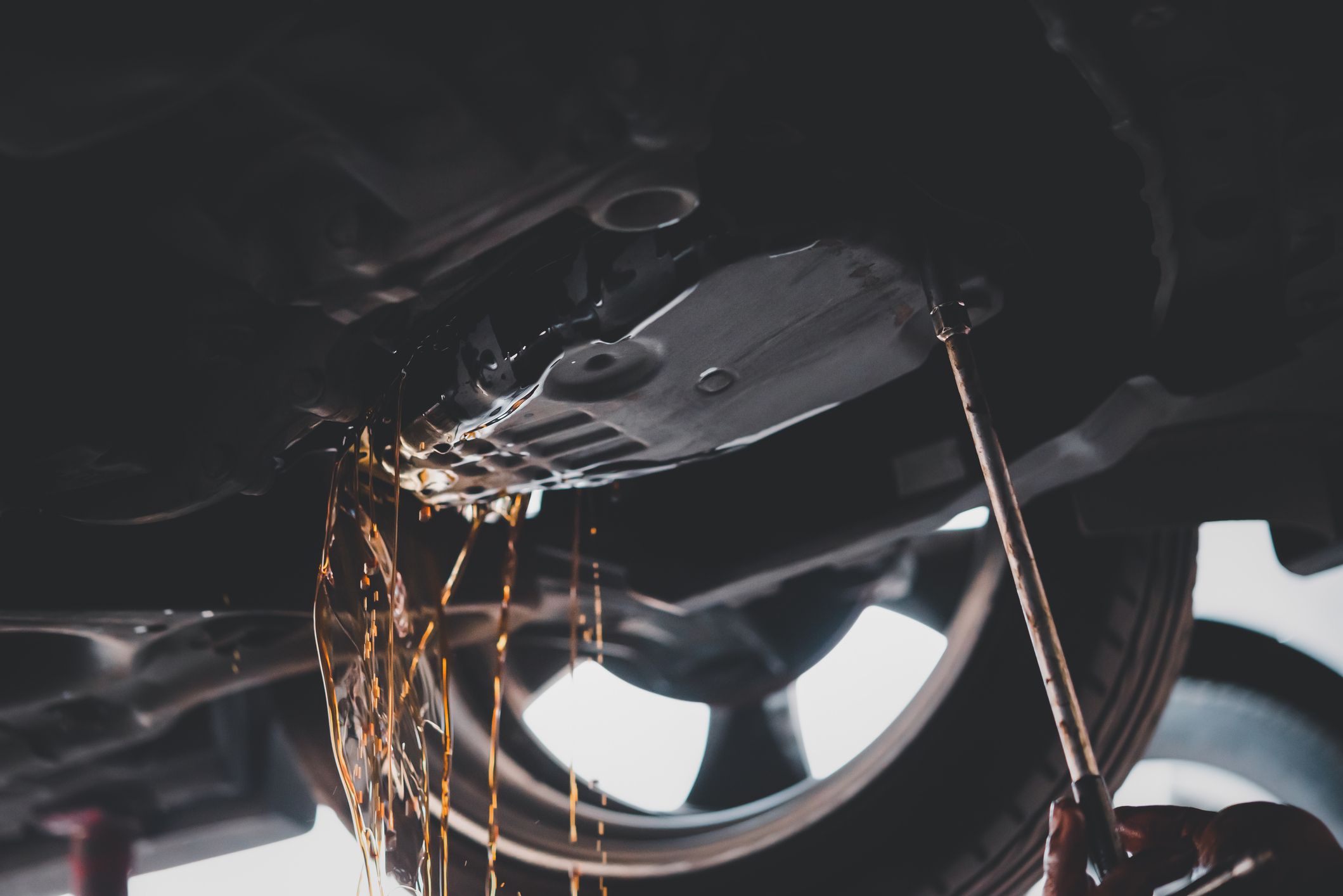
3. Transmission Replacement
How Much? $5,000
You’ve probably heard that replacing your transmission is one of the most costly repairs on a car – one that if needed to be done out of pocket may warrant trading the car in and getting a new one altogether. Your transmission is what makes your car drive and when it won’t drive, it’s a big uh-oh.
Save money: Again, routine car maintenance for all of the above work in line with your transmission. And when a mechanic or your vehicle’s manual suggests a transmission flush, do it. Sure, it will cost about $150 but it’s better than the alternative auto repair bill.
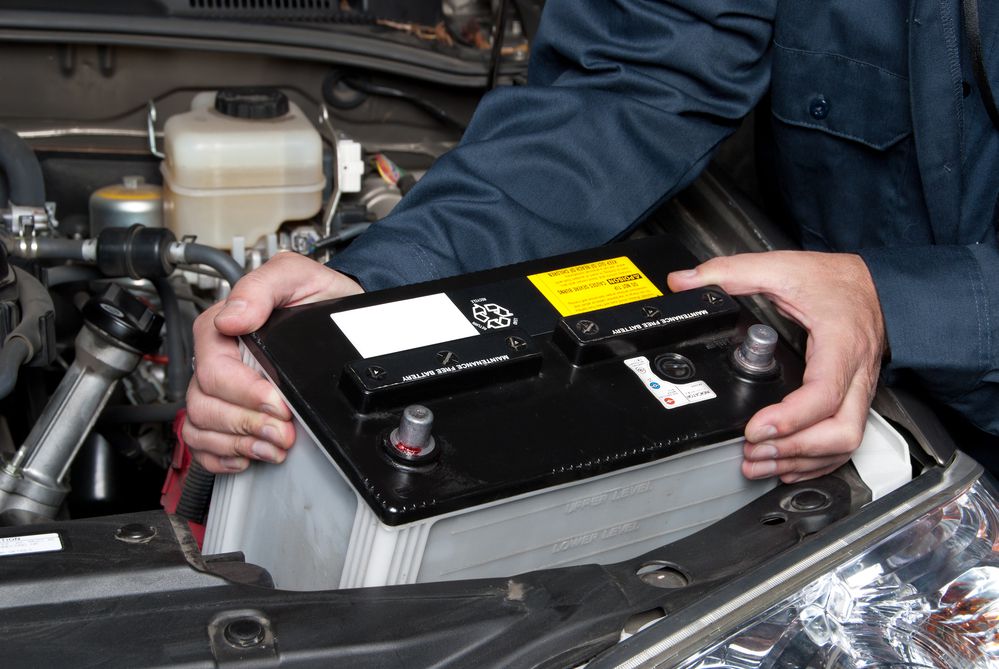
2. Hybrid car battery
How much? $6,000
While you’re working toward a better environment with a hybrid, your car repairs are typically higher, especially if you need a brand-new rechargeable battery. The batteries are expected to last up to 10 years but if it goes out, it, along with the car’s computer system, needs to be swapped out.
Save money: Coasting to a stop and slowly accelerating will both help extend the lifetime of your battery.
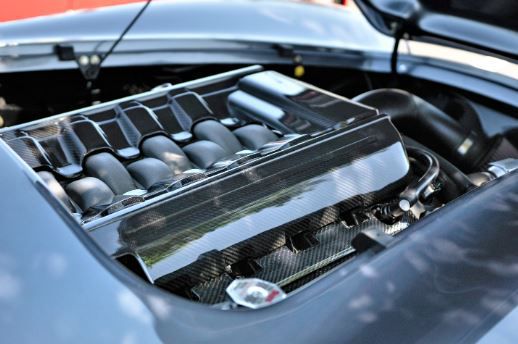
1. Engine Replacement
How much? $10,000
Your car cannot run without its engine or its cylinders. When the check engine light goes on, this is what we all hope is not the issue. The engine is a complex system and while we may not know how a car works, we do know the engine is important and the most expensive part of the vehicle. If your engine goes, dismantling the engine cylinders is tricky and labor-intensive – the expense may mean it’s time to get a new car.
Save money: All of the above!
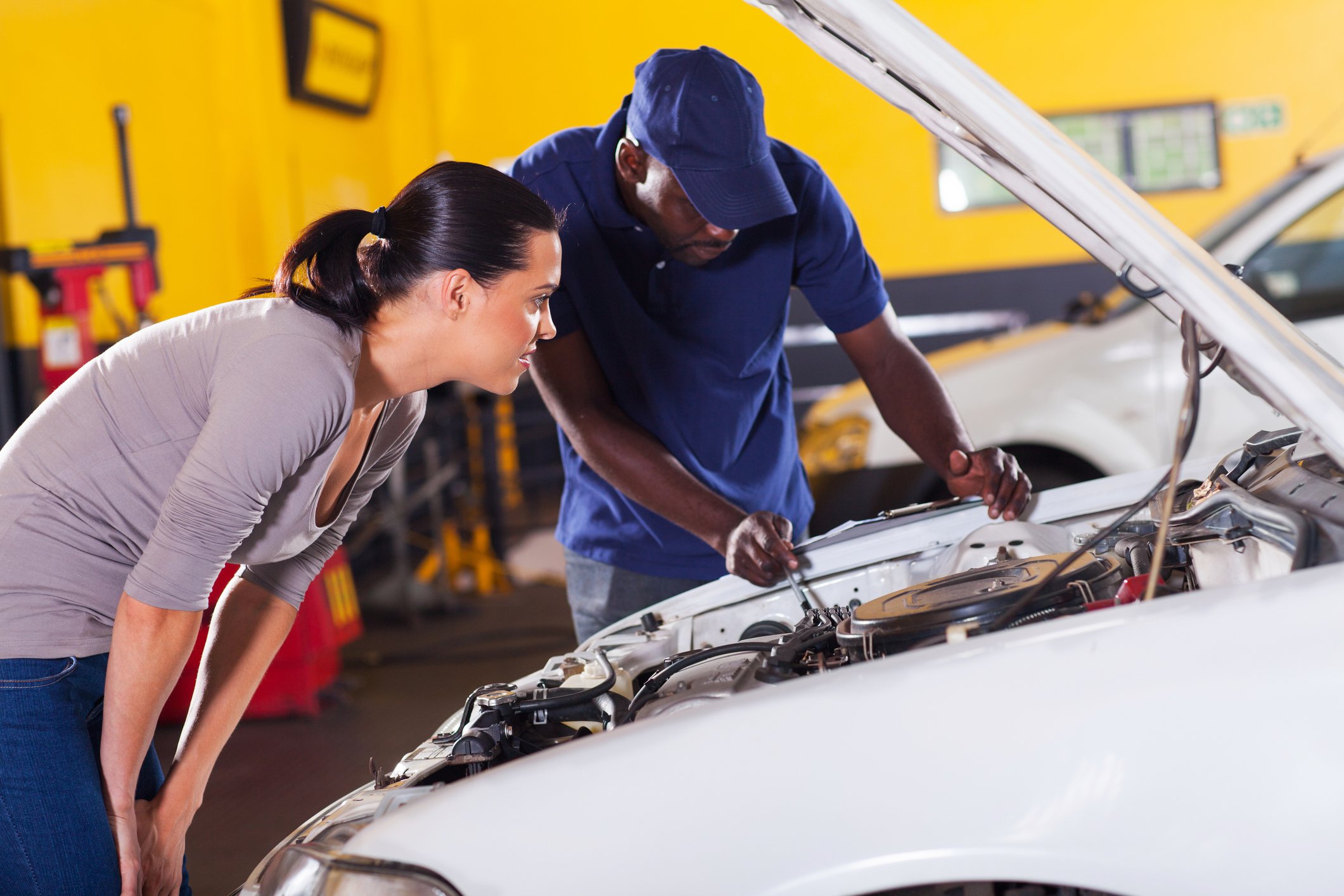
The bottom line
Car insurance only covers these repairs if they are a result of a collison or as state in your policy. The best way to save money on costly repairs is routine maintenance.

More from MediaFeed
Is this the future of air travel we have mixed feelings.
- Things You Should Never Do as a Legal Gun Owner
- The Biggest Mansion in Every State
More for You
Actor Chance Perdomo dies in motorcycle accident
McDonald’s brings beloved breakfast sandwich back to select locations
How to get rid of stink bugs, according to an entomologist
Manon Fiorot transported to hospital following win in UFC Atlantic City main event
Nate Berkus And Jeremiah Brent's Simple Tip For Making Any Home Smell Amazing
18 Things You’ll Still Want to Do After 60 But Probably Can’t
Netflix Drama: 25 Gripping Series That Will Keep You on the Edge of Your Seat
25 legendary musicians you might not know were LGBTQ+
Democrats unite against RFK Jr.
Zendaya Wears a Stormy Gray Gown with a Heart-Racing Deep V-Neckline
Can You Eat Potatoes with Sprouts?
10 Hiding Spots Burglars Always Look First
11 Actors Who Refused To Return For Reboots Of Their Iconic Movies And TV Shows (And Why)
Best Anime Adoptive Mothers & Stepmoms
Joe Biden Faces 'Clear' Evidence He Lied in Impeachment Probe—Attorney
How Long Should I Take to Walk a Mile?
How to Get Rid of Ants in Your House and Yard
Steelers 'Not Really Interested' In Big Name Quarterback Michael Penix Despite Meeting
Reacher Season 3: Expected Release, Plot, Cast & News
Vampire Frenzy: 16 Addictive Series That Suck Viewers into Their World
2018 Primetime Emmy & James Beard Award Winner
R&K Insider
Join our newsletter to get exclusives on where our correspondents travel, what they eat, where they stay. Free to sign up.
A History of Moscow in 13 Dishes
Featured city guides.
National Geographic content straight to your inbox—sign up for our popular newsletters here

Welcome to Hydra, the Greek island that said no thanks to cars
The mountainous island of Hydra, off the east coast of the Peloponnese, is a car-free zone where travellers explore on foot, by boat or from the saddle, taking life at a slow pace.
Looming into view, as the ferry from Athens approaches its harbour, Hydra seems like any other island at first. Fluttering Greek flags wave me into port, white houses gleam in the sunshine, all of them spilling down the hillside towards the calm sea. I can hear glasses clinking in harbour bars and see B & Bs owners beside the dock waiting to whisk visitors back to their premises.
Except these locals aren’t waiting, as they normally do in the Greek islands, in their cars. Hydra — off the east coast of the Peloponnese, 90 minutes by boat from Piraeus — is car-free. Even bicycles are banned, thanks to a 1950s law that sought to keep it as it’s always been — a labyrinth of alleys to be explored on foot, or aided by the island’s mules.
Flashing me a grin, Petros Feimi, the porter sent by the Orloff Hotel, my accommodation in the town of Hydra, tips my suitcase into his cart and trundles off with it along the cobbles, weaving around sandal-clad tourists, mules shifting idly from hoof to hoof and cats snoozing in the sun. He leads me uphill, like a pied piper, fielding ‘kalimera’s (‘good day’s) as he goes. Petros is strong — not even running my luggage up 30-odd steps can make him break a sweat.
“You get used to it,” says Harriet Jarman when I meet her the next morning, after walking through town to her stables, Harriet’s Hydra Horses. Her eight steeds are busy chewing noisily on fresh hay. “You see elderly women carrying three bags of shopping,” she says. “My son had to learn to walk at 18 months because I couldn’t carry him.”
Harriet was 10 when she and her mum moved from Buckinghamshire to Hydra. “We came on holiday and loved it, so we stayed,” she says simply, grooming Melina — a dappled grey rescue from the Peloponnese — under a gum tree. A life-long rider, Harriet was the first on this island of equines — there are over 1,000 of them here, all working animals — to offer horse-riding to visitors, in 2014.

“It’s a lot easier to see the island from the saddle,” she says. “There are lots of stairs and ups and downs here. On a horse, you can sit back and enjoy the view.” Harriet takes visitors along cliff-side mule tracks and up to monasteries in the mountains. “It’s 50-50 whether they let us in now. Before the pandemic, they’d invite us in for coffee.”
The next day, I catch sight of Harriet as I’m walking back from a beach swim, leading her group of horses along Hydra’s sole cliff path, which unfurls either side of town along a five-mile stretch of the north coast. Hydra is fairly barren with few roads; your only options to reach some of the coves is to sail or walk.
Boats are best for the furthest beaches, beyond the path: Bisti, a tiny cove backed by a rare grove of trees towards Hydra’s western tip; and Agios Nikolaos, a calm, gulf-like indent on the southwest coast set between mountains. But closer to town, walking becomes part of the experience.
This morning, I’d started out with a boat ride to Plakes beach, around two miles west of town, for my early dip. Now, I’m strolling along a ruddy dirt path that runs east back to town. It leads behind cottages and grand painted mansions built by wealthy shipowners in Hydra’s heyday in the 18th and 19th centuries — the Orloff Hotel is one such building, dating from 1798. Taxi boats skim across the water, the thumb of the Peloponnese hovering in the distance out to sea.
I pass a blue-domed church, then a cliffside amphitheatre — boho Hydra’s cultural scene peaked in the 1960s, when the likes of Leonard Cohen lived here — before dipping down to Vlychos beach. My efforts are rewarded with a feast of garlic-marinated anchovies and watermelon and feta salad at Enalion, a beachside restaurant set between acacia trees. Without cars, it’s so quiet I swear I hear the butterfly that lands on my table as I finish my goblet of Peloponnese red.
Following an afternoon on Vlychos beach, snoozing in the sun like one of those Hydriot cats, I head back to town, across a humped bridge and up the cliffside, watching the Peloponnese coastline unfurl across the water. The path lifts as gently as a Leonard Cohen song, past the tiny harbour of Kamini, where fishing boats bob; up again to a bench dedicated to Cohen; and past the cliffside restaurants marking the entrance to Hydra town. The sun is setting, the sea is flushing pink and alleyways of whitewashed houses spiral invitingly off from the waterfront. I’d worried that a car-free island might turn a break into a chore, but on Hydra, the journey really does make the experience.
LIMITED TIME OFFER
Receive up to 2 bonus issues, with any paid gift subscription!
Related Topics
- GREEN LIVING
- HORSEBACK RIDING
- SUSTAINABILITY
- SUSTAINABLE TOURISM
You May Also Like

The 31 best Greek islands to visit in 2024

20 of the coolest travel adventures for 2024

From renewable energy to backing communities: how hotels can make a difference

5 simple things you can do to live more sustainably

Whatever happened to the zero waste movement?
- History & Culture
- Photography
- Environment
- Paid Content
History & Culture
- Mind, Body, Wonder
- Terms of Use
- Privacy Policy
- Your US State Privacy Rights
- Children's Online Privacy Policy
- Interest-Based Ads
- About Nielsen Measurement
- Do Not Sell or Share My Personal Information
- Nat Geo Home
- Attend a Live Event
- Book a Trip
- Inspire Your Kids
- Shop Nat Geo
- Visit the D.C. Museum
- Learn About Our Impact
- Support Our Mission
- Advertise With Us
- Customer Service
- Renew Subscription
- Manage Your Subscription
- Work at Nat Geo
- Sign Up for Our Newsletters
- Contribute to Protect the Planet
Copyright © 1996-2015 National Geographic Society Copyright © 2015-2024 National Geographic Partners, LLC. All rights reserved
- Skip to main content
- Keyboard shortcuts for audio player
Some foreign-made cars might be delayed as auto companies figure out port deliveries

Camila Domonoske

Cars exit from the Baltimore Port after the cargo ship Dali ran into and collapsed the Francis Scott Key Bridge in Baltimore, Md., on Tuesday. Two people were pulled alive from the water, two bodies were recovered and four people were presumed dead. The men were working on the bridge at the time of the collision at 1:30 a.m. Kena Betancur/Getty Images hide caption
Cars exit from the Baltimore Port after the cargo ship Dali ran into and collapsed the Francis Scott Key Bridge in Baltimore, Md., on Tuesday. Two people were pulled alive from the water, two bodies were recovered and four people were presumed dead. The men were working on the bridge at the time of the collision at 1:30 a.m.
When the Francis Scott Key Bridge was struck by a cargo ship and collapsed, it was a shocking disaster that took the lives of six men working on the bridge at the time.
It also blocked off much of the port.
That raised alarm bells in the auto industry — because the Port of Baltimore handles more cars and light trucks than any other port in the U.S., and clearing the debris could take months .
Automakers were quick to emphasize that they were adapting . GM says it is rerouting deliveries. Stellantis is working on "contingency plans." Mercedes says it has options. Mazda says it has yet to finalize alternatives to this "vital" port. But it's not easy.

What we know and don't know about Baltimore's Key Bridge collapse
More from WYPR in Baltimore:
- Construction worker says friends, colleagues missing in bridge collapse
- Federal government pledges full support to rebuild FSK bridge, reopen port
For the latest from member station WYPR in Baltimore head to wypr.org
Imported cars travel in special ships
That's because rerouting an imported vehicle is a lot more complicated than redirecting a shipping container . Not all ports are equally equipped to unload the vessels that carry vehicles — a special "roll-on roll-off," or ro-ro ship.
And once unloaded, vehicles need to be inspected for damage and often need to have accessories or electronics installed. There's important paperwork after a car comes off a ship before it can can go to a dealer.
That all happens at a port facility that's typically built right next to where the ships unload, and it's a big reason why the vessels can't be sent just anywhere — even if you can get them off the ship at another port, who's going to install the subwoofers and finalize the window sticker?
Still, companies have several options, even though these might cause delays.
Part of the Baltimore port can still accept vehicles
First, part of the Baltimore port that handles vehicles is still operational.
The Tradepoint Atlantic terminal is located at the mouth of the harbor, before the Francis Scott Key Bridge. Volkswagen and BMW operate there, and as a result, those two automakers expect no impacts from the disaster. On Wednesday, a ship with Volkswagens arrived and was able to dock like normal.
Tradepoint Atlantic says its operation is "well equipped to handle additional levels of [vehicle] cargo. Plans to accept redirected cargo are underway, including the ability to handle the increased capacity."
Unload cars at a different port and drive them to Baltimore
Second, automakers could unload vehicles from a ship at a different port altogether and then drive them to their Baltimore facilities for those crucial processing steps, like inspections and part installations.
The Port of New York and New Jersey says it would be able to take vehicles off a ship and put them immediately on a car carrier truck bound for Baltimore, three hours away.
"Our thoughts are with all of those impacted by this collapse," Bethann Rooney, port director, said in a statement, adding that the port "is proactively working with our industry partners to respond as needed and ensure supply chain continuity along the East Coast."
Those two options would also have a benefit for Baltimore as the city reels from the loss of a crucial bridge. They would allow at least some port jobs to continue, boosting the local economy, while the waterways are blocked.
Cars can also go to vehicle-focused ports farther away
As a third option, automakers could use a port farther afield, where they are already processing other vehicles.
For instance, Brunswick in Georgia is the second busiest port for vehicles after Baltimore — and Mercedes and Subaru, which import many vehicles through Baltimore, also have large processing operations there.
Officials at Brunswick say that the port has been contacted by companies as an interim solution while the Baltimore port is partially blocked, and that the port has unused capacity to process another 200,000 vehicles per year.
So that one port could absorb a significant chunk of the vehicles normally routed through Baltimore, which processed just shy of 850,000 vehicles last year. Other ports are also home to vehicle processing centers.
However, using a more distant port would mean a longer journey to dealerships. On the upside, because many vessels carrying vehicles make multiple stops up and down the East Coast, it might not require a detour at sea; that ro-ro ship would just unload more vehicles than originally planned at other ports, to make up for what it can't drop off at Baltimore.
Automakers and logistic companies could use a combination of strategies to address this shipping disruption.
- International
March 26, 2024 - Baltimore Key Bridge collapses after ship collision
By Helen Regan , Kathleen Magramo , Antoinette Radford, Alisha Ebrahimji , Maureen Chowdhury , Rachel Ramirez , Elise Hammond , Aditi Sangal , Tori B. Powell , Piper Hudspeth Blackburn and Kathleen Magramo , CNN
What to know about the Francis Scott Key Bridge
From CNN's Kathleen Magramo

The 1.6-mile-long Francis Scott Key Bridge extends over the Patapsco River into the Port of Baltimore, according to the Maryland Transport Authority (MTA).
The bridge, which opened in 1977, is named after the author of "The Star-Spangled Banner," the MTA says on its website. Francis Scott Key is believed to have sat near the site of the bridge as he witnessed the bombardment of Fort McHenry in 1814, inspiring him to write the words of the US national anthem.
The Port of Baltimore handled more than 52 million tons of international cargo worth over $80 billion last year — the ninth-highest total among US ports, according to the Maryland government's website .
The port supports 15,330 direct jobs and 139,180 jobs in Maryland, according to the site.
Baltimore mayor says he is "aware" of bridge collapse and en route to site
From CNN staff
Baltimore Mayor Brandon M. Scott says he is "aware of and en route to the incident at the Key Bridge."
"I have been in contact with @BaltimoreFire Chief Wallace, @GovWesMoore @JohnnyOJr, and @AACoExec. Emergency personnel are on scene, and efforts are underway," he posted on X Tuesday.
Video shows moment the Francis Scott Key Bridge collapsed
From CNN's Helen Regan
Video footage shows the moment the Francis Scott Key Bridge in Baltimore collapsed after it was struck by a large ship.
The footage shows a towering boat headed directly toward one of the bridge’s support columns before colliding with it, sending a massive stretch of the bridge crashing into the water below in mere seconds.
The crash sent large plumes of smoke and fire into the air and part of the bridge appeared to collapse over the front of the boat, the footage showed.
Dark smoke continued to rise into the air for several minutes.
Francis Scott Key Bridge in Baltimore collapses after being stuck by large ship
From CNN's Melissa Alonso
The Francis Scott Key Bridge in Baltimore collapsed early Tuesday morning after it was struck by a large ship, according to video obtained by CNN.
It is unclear if anyone was injured.
Maryland Transportation Authority (MTA) says all traffic is being detoured.
CNN has reached out to Baltimore City Fire Department for additional information.
The 1.6-mile, four-lane bridge extends over the Patapsco River and serves as the outermost crossing of the Baltimore harbor and an essential link of Interstate-695, or the Baltimore Beltway.
Please enable JavaScript for a better experience.
Advertisement
‘A Lot of Chaos’: Bridge Collapse Creates Upheaval at Largest U.S. Port for Car Trade
A bridge collapse closed Baltimore’s port, an important trade hub that ranks first in the nation by the volume of automobiles and light trucks it handles.
- Share full article
Shipping in the Port of Baltimore
Monthly cargo handled by the Port of Baltimore

By Peter Eavis and Jenny Gross
- March 26, 2024
The Baltimore bridge disaster on Tuesday upended operations at one of the nation’s busiest ports, with disruptions likely to be felt for weeks by companies shipping goods in and out of the country — and possibly by consumers as well.
The upheaval will be especially notable for auto makers and coal producers for whom Baltimore has become one of the most vital shipping destinations in the United States.
As officials began to investigate why a nearly 1,000-foot cargo ship ran into the Francis Scott Key Bridge in the middle of the night, companies that transport goods to suppliers and stores scrambled to get trucks to the other East Coast ports receiving goods diverted from Baltimore. Ships sat idle elsewhere, unsure where and when to dock.
“It’s going to cause a lot of chaos,” said Paul Brashier, vice president for drayage and intermodal at ITS Logistics.
The closure of the Port of Baltimore is the latest hit to global supply chains, which have been strained by monthslong crises at the Panama Canal, which has had to slash traffic because of low water levels; and the Suez Canal, which shipping companies are avoiding because of attacks by the Houthis on vessels in the Red Sea.
The auto industry now faces new supply headaches.
Last year, 570,000 vehicles were imported through Baltimore, according to Sina Golara, an assistant professor of supply chain management at Georgia State University. “That’s a huge amount,” he said, equivalent to nearly a quarter of the current inventory of new cars in the United States.
The Baltimore port handled a record amount of foreign cargo last year, and it was the 17th biggest port in the nation overall in 2021, ranked by total tons, according to Bureau of Transportation Statistics.
Baltimore Ranks in the Top 20 U.S. Ports
Total trade in 2021 in millions of tons
Baltimore ranks first in the United States for the volume of automobiles and light trucks it handles, and for vessels that carry wheeled cargo, including farm and construction machinery, according to a statement by Gov. Wes Moore of Maryland last month.
The incident is another stark reminder of the vulnerability of the supply chains that transport consumer products and commodities around the world.
The extent of the disruption depends on how long it takes to reopen shipping channels into the port of Baltimore. Experts estimate it could take several weeks.
Baltimore is not a leading port for container ships, and other ports can likely absorb traffic that was headed to Baltimore, industry officials said.
Stephen Edwards, the chief executive of the Port of Virginia, said it was expecting a vessel on Tuesday that was previously bound for Baltimore, and that others would soon follow. “Between New York and Virginia, we have sufficient capacity to handle all this cargo,” Mr. Edwards said, referring to container ships.
“Shipping companies are very agile,” said Jean-Paul Rodrigue, a professor in the department of maritime business administration at Texas A&M University-Galveston. “In two to three days, it will be rerouted.”
But other types of cargo could remain snarled.
Alexis Ellender, a global analyst at Kpler, a commodities analytics firm, said he expected the port closure to cause significant disruption of U.S. exports of coal. Last year, about 23 million metric tons of coal exports were shipped from the port of Baltimore, about a quarter of all seaborne U.S. coal shipments. About 12 vessel had been expected to leave the port of Baltimore in the next week or so carrying coal, according to Kpler.
He noted that it would not make a huge dent on the global market, but he added that “the impact is significant for the U.S. in terms of loss of export capacity.”
“You may see coal cargoes coming from the mines being rerouted to other ports instead,” he said, with a port in Norfolk, Va., the most likely.
If auto imports are reduced by Baltimore’s closure, inventories could run low, particularly for models that are in high demand.
“We are initiating discussions with our various transportation providers on contingency plans to ensure an uninterrupted flow of vehicles to our customers and will continue to carefully monitor this situation,” Stellantis, which owns Chrysler, Dodge, Jeep and Ram, said in a statement.
Other ports have the capacity to import cars, but there may not be enough car transporters at those ports to handle the new traffic.
“You have to make sure the capacity exists all the way in the supply chain — all the way to the dealership,” said Mr. Golara, the Georgia State professor.
A looming battle is insurance payouts, once legal liability is determined. The size of the payout from the insurer is likely to be significant and will depend on factors including the value of the bridge, the scale of loss of life compensation owed to families of people who died, the damage to the vessel and disruption to the port.
The ship’s insurer, Britannia P&I Club, part of a global group of insurers, said in a statement that it was “working closely with the ship manager and relevant authorities to establish the facts and to help ensure that this situation is dealt with quickly and professionally.”
The port has also increasingly catered to large container ships like the Dali, the 948-foot-long cargo vessel carrying goods for the shipping giant Maersk that hit a pillar of the bridge around 1:30 a.m. on Tuesday. The Dali had spent two days in Baltimore’s port before setting off toward the 1.6-mile Francis Scott Key Bridge.
State-owned terminals, managed by the Maryland Port Administration, and privately owned terminals in Baltimore transported a record 52.3 million tons of foreign cargo in 2023, worth $80 billion.
Materials transported in large volumes through the city’s port include coal, coffee and sugar. It was the ninth-busiest port in the nation last year for receiving foreign cargo, in terms of volume and value.
The bridge’s collapse will also disrupt cruises traveling in and out of Baltimore. Norwegian Cruise Line last year began a new fall and winter schedule calling at the Port of Baltimore.
An earlier version of this article misstated the Port of Baltimore’s rank among U.S. ports. It was the nation’s 17th biggest port by total tons in 2021, not the 20th largest.
How we handle corrections
Peter Eavis reports on business, financial markets, the economy and companies across different sectors. More about Peter Eavis
Jenny Gross is a reporter for The Times in London covering breaking news and other topics. More about Jenny Gross
See how the Key Bridge collapse will disrupt the supply of cars, coal and tofu
The port of baltimore is the top port in the nation for automobile shipments.
The collapse of the Francis Scott Key Bridge in Baltimore on Tuesday cut off access to much of the city’s port — causing a suspension of vessel traffic that will disrupt a key trade lane and threaten to further tangle already-stressed supply chains.
The Port of Baltimore was the 17th largest in the nation by total tons in 2021 and an important artery for the movement of autos, construction machinery and coal. It handled 52.3 million tons of foreign cargo worth nearly $81 billion in 2023, according to Maryland data, and creates more than 15,000 jobs.

Top 10 imports and exports to the Port
of Baltimore in 2023
2023 total: $59B
electronics
commodities
2023 total: $22B
Iron, steel
Seeds, grains,
fruits, plants
Air and space
craft, parts
Coal, oil and
natural gas
Note: not seasonally adjusted. Vehicles excluding railways
and tramways. Nickel, aluminium, paper and wood include
derivatives of those commodities
Source: Census Bureau

Top ten imports and exports to the Port of Baltimore in 2023
Electronic machinery
and electronics
farmwork and
construction
Iron and steel
spacecraft, parts
Note: not seasonally adjusted. Vehicles excluding railways and tramways. Nickel, aluminium,
paper and wood include derivatives of those commodities

spacecraft,
bedding, lights
Note: not seasonally adjusted. Vehicles excluding railways and tramways. Nickel, aluminium, paper and wood include
On Tuesday, the Port of Baltimore said that vessel traffic would be suspended in and out of the port until further notice, but trucks would still be processed in its terminals.
“Baltimore’s not one of the biggest ports in the United States, but it’s a good moderate-sized port,” said Campbell University maritime historian Sal Mercogliano. It has five public and 12 private terminals to handle port traffic.

North Locust
Point Marine
Ports and terminals
Baltimore Port
Truck Plaza
Seagirt Marine
Dundalk Marine
Shipping channels
CSX Coal Pier
Francis Scott
Hawkins Point
Marine Terminal

“It does cars, it does bulk carriers, it does containers, it does passengers.” said Mercogliano. “So this is going to be a big impact.”
Baltimore’s the top port in the nation for automobile shipments, having imported and exported more than 750,000 vehicles in 2022, according to the Alliance for Automotive Innovation, an industry group.
About three-quarters of the autos that travel through the port are imports, dominated by big-name brands, including Mazda and Mercedes-Benz. Most of the top companies have enough inventory sitting on U.S. dealer lots that any immediate impact on supply is unlikely, said Ambrose Conroy, chief executive of the consulting firm Seraph.
“It’s too early to say what impact this incident will have on the auto business, but there will certainly be a disruption,” said John Bozzella, president of the Alliance for Automotive Innovation.
The port ranked second in the country for exporting coal last year, according to the state of Maryland. But it’s not a huge global supplier of thermal coal, and the disruption can likely be made up by replacements from Australia or Indonesia if needed, said Alexis Ellender, lead analyst at global trade intelligence company Kpler.
Baltimore is also a niche port for the soybean trade, focusing mostly on high-value soy used in tofu, miso, tempeh and organic products, according to Mike Steenhoek, executive director of the Soy Transportation Coalition. Most of those exports are destined for Asia, but Steenhoek doesn’t expect a big spike in tofu prices because several other U.S. ports also ship this sort of soy, including Norfolk, Va., Savannah, Ga. and Charleston, S.C.
All East Coast ports have become more important in recent years as the United States attempts to boost its trade with friendly nations and reduce geopolitical risks related to trade with China, which generally happens via West Coast ports, said Tinglong Dai, a Johns Hopkins Carey Business School professor and expert on global supply chains.
Baltimore port’s suspension is “one more disruption in an already-stressed system” for the global supply chain, said Abe Eshkenazi, chief executive of the Association for Supply Chain Management. Cargo will now have to be rerouted to other ports, which means figuring out where there is enough capacity to move things.

East Coast ports and shipping density
Ship traffic
Philadelphia
of Baltimore
5th-largest port
on the East Coast
for foreign trade
Newport News
Morehead City

East Coast ports
and shipping density
PENNSYLVANIA
The Port of Baltimore
5th-largest port on the
East Coast for foreign trade
Coal shipments will need to be rerouted to other ports, Kpler’s Ellender said. And Ryan Petersen, chief executive of the logistics company Flexport, posted on X that the company currently has 800 containers on a slew of ships heading for the port that will need to be rerouted, likely to Philadelphia or Norfolk.
The biggest problem Steenhoek sees from Baltimore’s shuttering is the knock-on effect to other ports. Many ships stuck in the port were destined to make stops at other U.S. ports to load and unload goods before heading overseas, a complicated logistical dance now scrambled by the bridge collapse.
“It just shows how you throw a wrench in the supply chain and the impact is not just confined to that one port,” Steenhoek said.
Tim Meko, Justine McDaniel and David J. Lynch contributed to this report. Editing by Kate Rabinowitz and Karly Domb Sadof.
Baltimore bridge collapse
How it happened: Baltimore’s Francis Scott Key Bridge collapsed after being hit by a cargo ship . The container ship lost power shortly before hitting the bridge, Maryland Gov. Wes Moore (D) said. Video shows the bridge collapse in under 40 seconds.
Victims: Divers have recovered the bodies of two construction workers , officials said. They were fathers, husbands and hard workers . A mayday call from the ship prompted first responders to shut down traffic on the four-lane bridge, saving lives.
Economic impact: The collapse of the bridge severed ocean links to the Port of Baltimore, which provides about 20,000 jobs to the area . See how the collapse will disrupt the supply of cars, coal and other goods .
Rebuilding: The bridge, built in the 1970s , will probably take years and cost hundreds of millions of dollars to rebuild , experts said.
- Baltimore bridge collapse: Crane arrives at crash site to aid cleanup March 29, 2024 Baltimore bridge collapse: Crane arrives at crash site to aid cleanup March 29, 2024
- Officials studied Baltimore bridge risks but didn’t prepare for ship strike March 29, 2024 Officials studied Baltimore bridge risks but didn’t prepare for ship strike March 29, 2024
- Baltimore begins massive and dangerous cleanup after bridge collapse March 28, 2024 Baltimore begins massive and dangerous cleanup after bridge collapse March 28, 2024


IMAGES
VIDEO
COMMENTS
What is Suspension Travel? Suspension travel is defined as the maximum vertical distance that the wheel can travel from the fully extended 'Rebound' condition to the fully compressed 'Full Bump' condition. 'Bump Travel' is defined as the distance traveled by the wheel center from Normal ride height to Full Bump condition.
More suspension travel results in a smoother ride. Imagine a car speeding towards a brick wall. The average force (and acceleration) required to bring a moving body to rest is inversely proportional to the stopping distance. The ability of a shock-mitigating device to lessen an impact and ensure a smooth ride is tied to its stopping distance.
In conclusion, suspension travel and motion ratio are crucial aspects of suspension design and tuning that can greatly affect a car's performance. The required suspension travel varies depending on the application, and a proper understanding of motion ratio is necessary for comparing spring rates between different cars. By optimizing ...
As such, you don't need to set up your suspension to handle rough terrain. What you DO need, though, is a suspension setup that gives your bike stability and precision. And short suspension travel is ideal for this type of riding. On average, suspension with short travel will be set to between 80-120mm.
Most mid travel systems for this platform will net around 10 inches of suspension travel with just an aftermarket UCA and coilover. Most long travel systems for this platform will net 13 inches or more of suspension travel. And depending on the components, some can attain as much as 18 inches of travel, all while retaining four wheel drive.
Brake linescarry hydraulic pressure from the master cylinder to the wheel cylinders until it reaches the brake calipers. In a long travel suspension system, the brake calipersare farther from the frame, which can affect the vehicle's stopping power during sudden stops. Extended brake lines can help prevent the loss of braking power.
Now, consider a car with a same amount of wheel travel, and a very soft suspension, with spring rates of only 10 N/mm. A force of 760 N would take up all the wheel travel (10 N/mm x 76 mm = 760 N; so if a force of 890 N were applied, not only would the springs be fully compressed, but a force 130 N would be applied to the body.
Number Two: Travel In the example above, the Red Car cuts the apex properly. The Blue Car exhibits oversteer while the Yellow Car suffers from understeer. ... There are ways to maximize the amount of usable suspension travel range that involve adding more parts and making more changes to the entire system to balance out all the other dynamic ...
The frame: structural, load-carrying component that supports the car's engine and body, which are in turn supported by the suspension; The suspension system: setup that supports weight, absorbs and dampens shock and helps maintain tire contact; The steering system: mechanism that enables the driver to guide and direct the vehicle; The tires and wheels: components that make vehicle motion ...
A car has four independent wheels, which travel at different speeds, and are subject to various forces. That's why an independent suspension is the best for everything, including off-roading.
The suspension system is located between the frame and the wheels and serves multiple important purposes. Ideally, well-tuned suspension will absorb bumps and other imperfections in the road so the people inside the car can travel comfortably. While this is very important from a passenger's perspective, the driver will notice certain other ...
A twin-tube design allows for more suspension travel in a given space compared to a monotube design, which combined with lowered gas pressure, often results in better ride characteristics. Most production car dampers are twin-tube. Most street car dampers feature a fixed spring perch and ride height.
For straight axle applications, most cars will require a shock with five inches of stroke or so. This allows for the 2.5" of compression travel and 2.5" of extension travel mentioned above. Independent suspensions will vary depending on their design. Use the method mentioned above to measure your shock amounts and find out how much stroke ...
Most production automobiles have a wide range of suspension travel, so their suspensions are designed to have benign characteristics within that scope. However, lowering a car can easily shift the suspension into an area where the geometry does all kinds of wacky things. Massive toe changes can occur with the slightest up or down movement.
If this is your first build, or your first build where you are having wheelie issues or too much suspension travel, travel limiters can be your best friend. ...
Step 3: Align it, test it, and go back to Steps 1 or 2 if the tires aren't doing their job. Step 4: Select the right anti-sway bars based upon what happened during Step 3. Step 5: Align it, test ...
Part of car suspension system consists of shock absorber, axle, frame and spring Part of car front suspension and steering mechanism: tie rod, steering arm, king pin axis (using ball joints). Van Diemen RF01 Racing Car Suspension.. Suspension is the system of tires, tire air, springs, shock absorbers and linkages that connects a vehicle to its wheels and allows relative motion between the two.
Long Travel Suspension Fundamentals. Longer upper and lower control arms that push the wheels farther away from the vehicle's center line, up to 6 inches per side, allowing the wheels to vertically move farther. Longer coilover front shock absorbers with remote reservoirs that have longer travel, allowing the suspension arms to move farther.
1. Measure your suspension travel by putting electrical ties on the shaft of your shock. Push it all the way agains the shock body when the car is at rest. The compression of the shock will push the tie wrap up and give you a water mark of how far it was compressed. You should perform several tests by driving the car through a variety of ...
If you don't have car insurance, replacing a windshield can average $300. Save money: Thankfully, most insurance carriers charge no more than $100 for replacement.
1: Off-kilter genius at Delicatessen: Brain pâté with kefir butter and young radishes served mezze-style, and the caviar and tartare pizza. Head for Food City. You might think that calling Food City (Фуд Сити), an agriculture depot on the outskirts of Moscow, a "city" would be some kind of hyperbole. It is not.
The mountainous island of Hydra, off the east coast of the Peloponnese, is a car-free zone where travellers explore on foot, by boat or from the saddle, taking life at a slow pace. By Julia ...
It is a two-level arch bridge, an upper level where cars drive and a lower level through which Metro trains and people travel. Opened in 1959, it was rebuilt between 1997 and 2002. This bridge connects Luzhniki with Sparrow Hills, although since 2018 pedestrians have the new Vorobyovy Gory Cable Car as an alternative for crossing the river at ...
The Francis Scott Key Bridge was opened in 1977 and carried more than 12.4 million vehicles last year. The bridge was one of the three major ways to cross the Patapsco River and formed part of ...
Imported cars travel in special ships. That's because rerouting an imported vehicle is a lot more complicated than redirecting a shipping container.Not all ports are equally equipped to unload the ...
The 1.6-mile-long Francis Scott Key Bridge extends over the Patapsco River into the Port of Baltimore, according to the Maryland Transport Authority (MTA).
See how the collapse will disrupt the supply of cars, coal and other goods. Rebuilding: The bridge, built in the 1970s , will probably take years and cost hundreds of millions of dollars to ...
The bridge collapse that has indefinitely halted the flow of ships in and out of the Port of Baltimore could hurt the local economy, strain supply chains and scramble deliveries along the US East ...
'A Lot of Chaos': Bridge Collapse Creates Upheaval at Largest U.S. Port for Car Trade. A bridge collapse closed Baltimore's port, an important trade hub that ranks first in the nation by the ...
The suspension of vessel traffic to the Port of Baltimore will add another disruption to already stressed supply chains, experts say. ... About three-quarters of the autos that travel through the ...